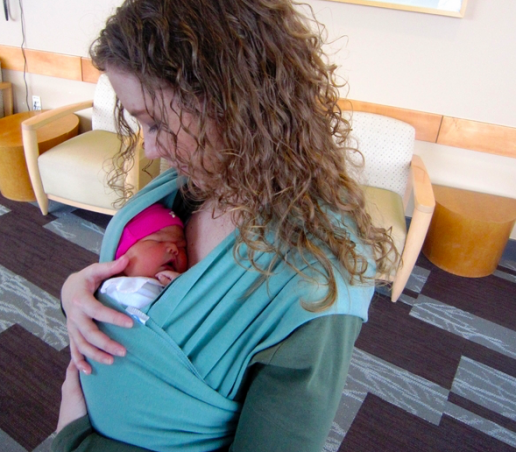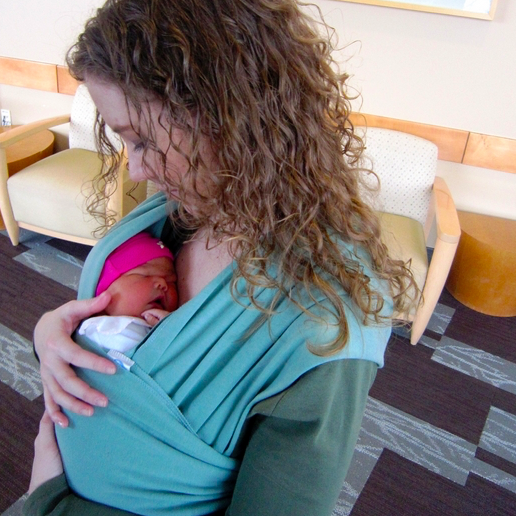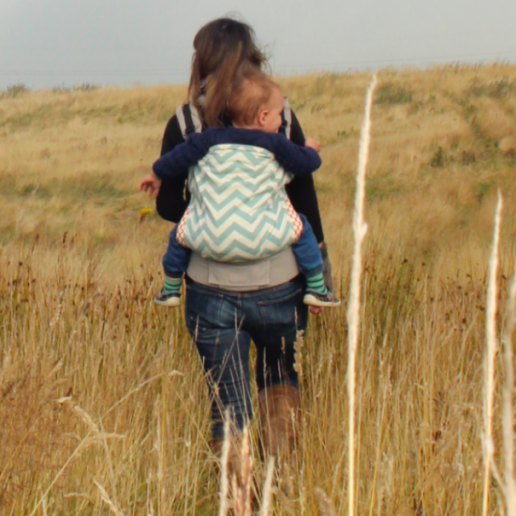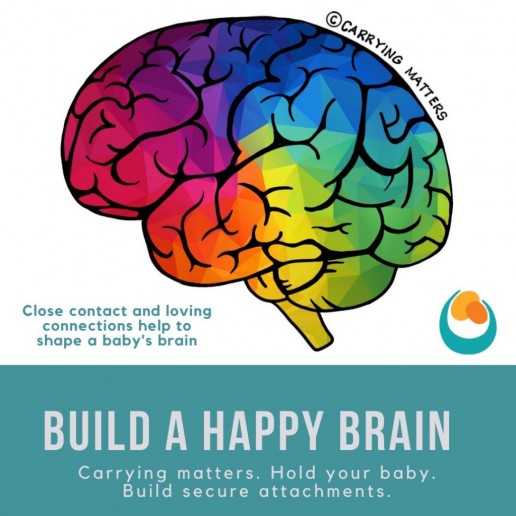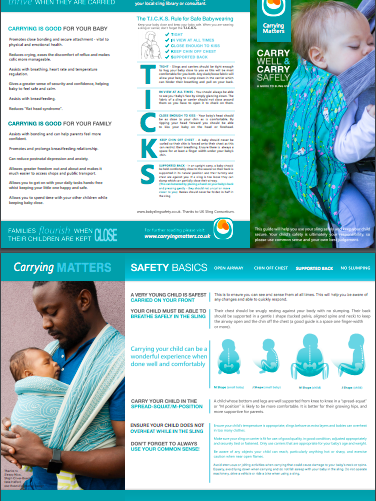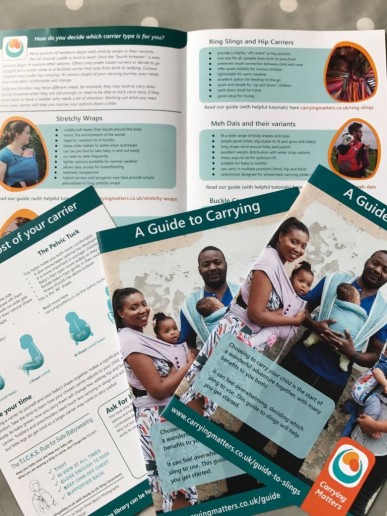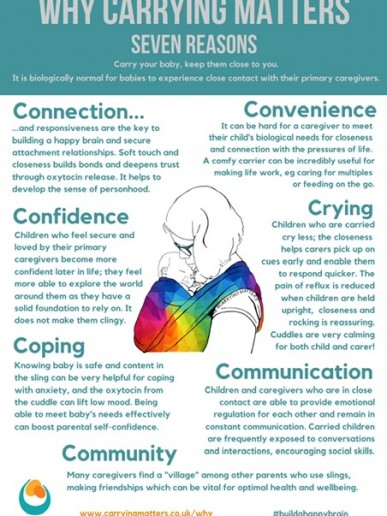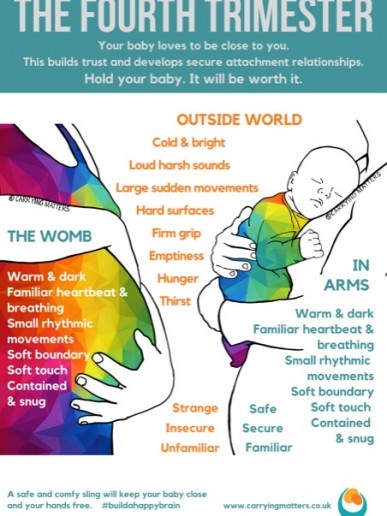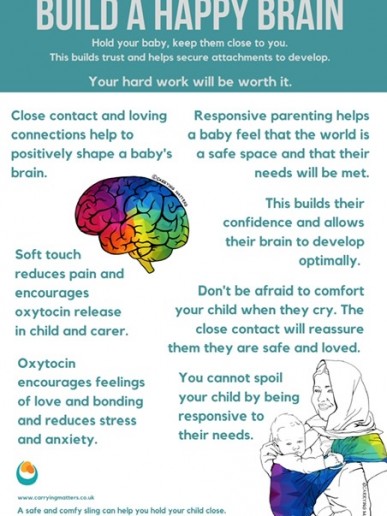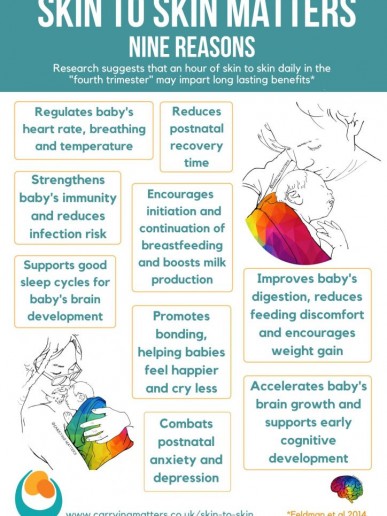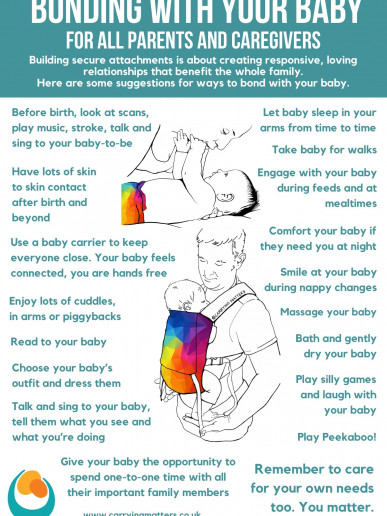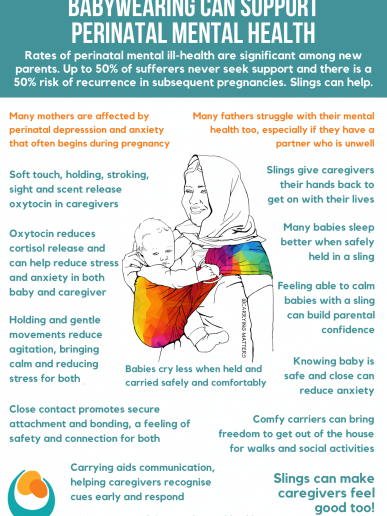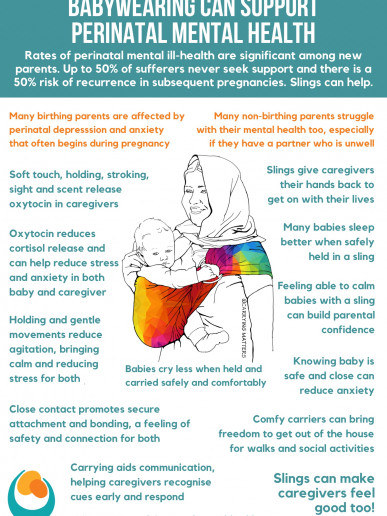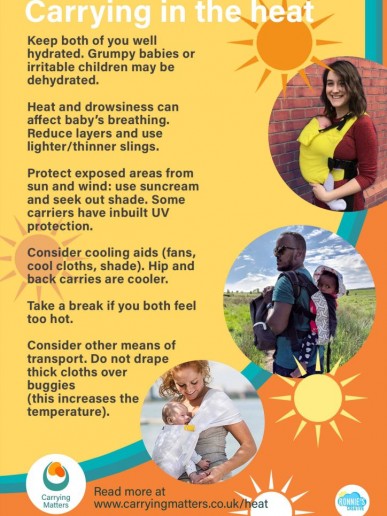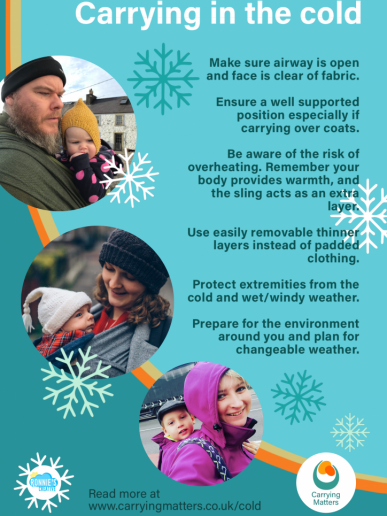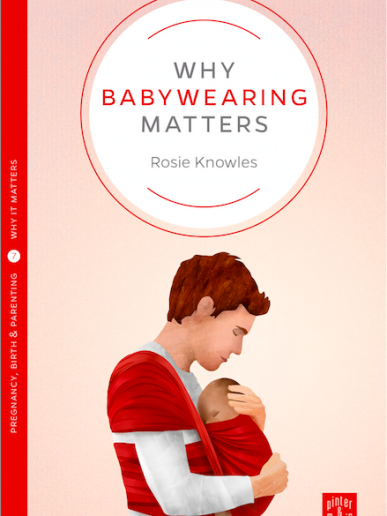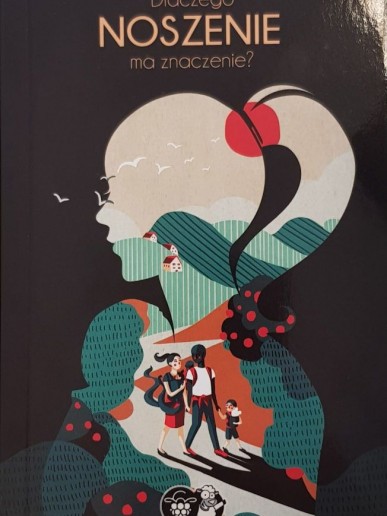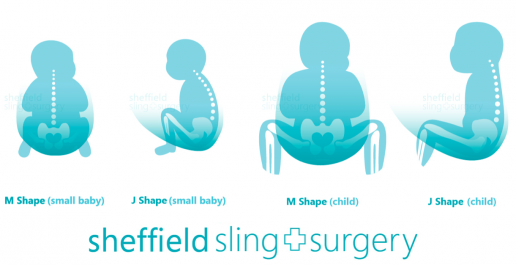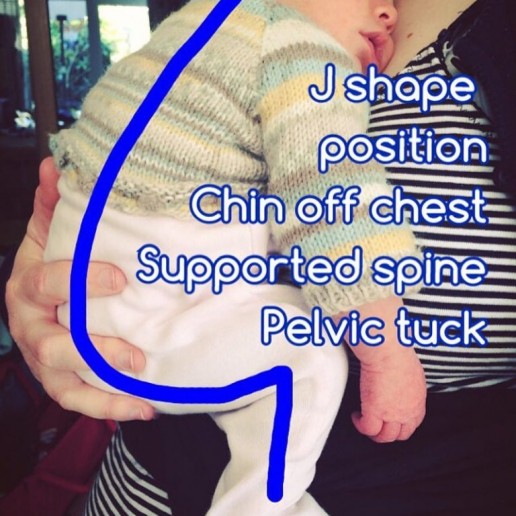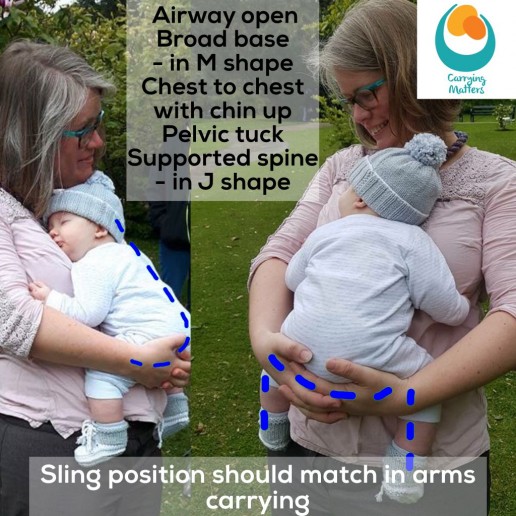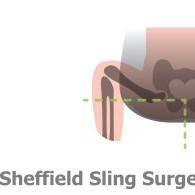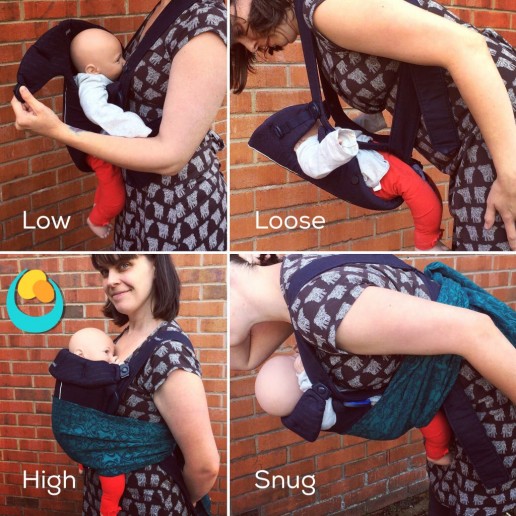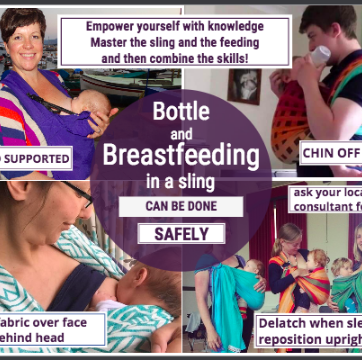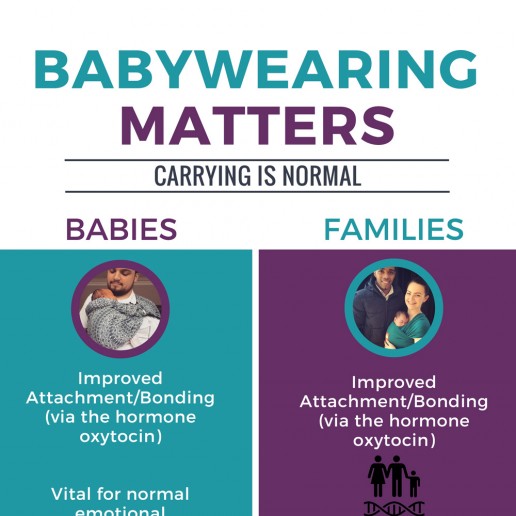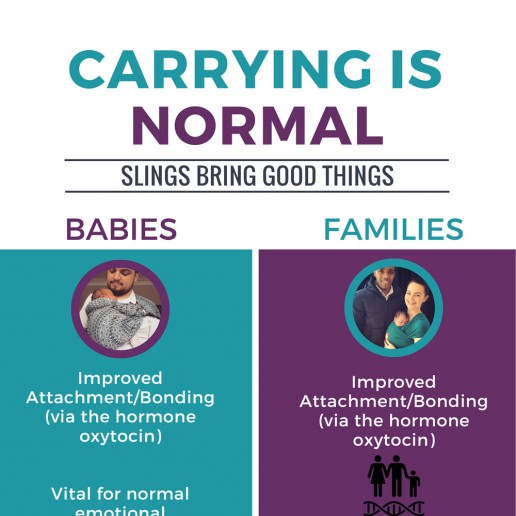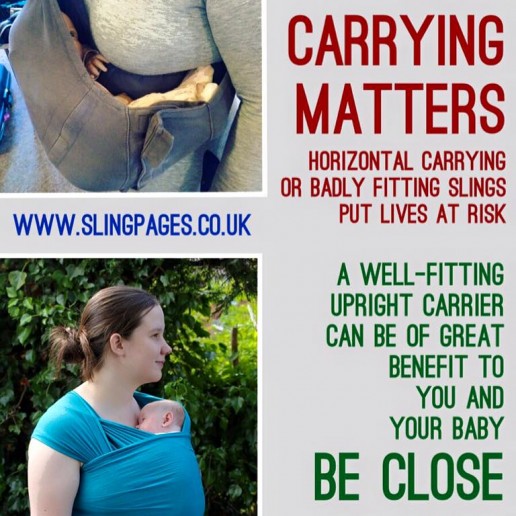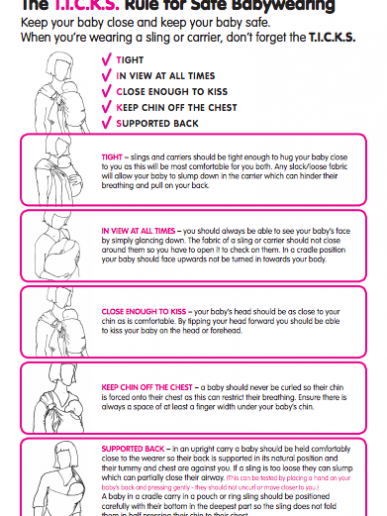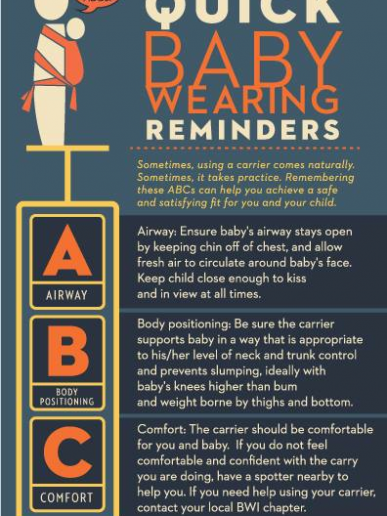Safe Carrier Height
Safe Height of Baby Carriers
It is very important to ensure babies' airways are unobstructed at all times in all types of carrier, at all ages. This is of particular concern for young and small babies due to their anatomical considerations and their vulnerability, as well as their tendency to fall asleep when feeling warm and safe.
Babies are born with large, heavy heads with a prominent occipital curve (the solid bone at the back). This is more pronounced in babies than in older children and adults, and is often known as "nature's pillow". They also have large tongues and short necks, which makes it easier for their airway to become compressed and lost, making it hard for them to breathe.
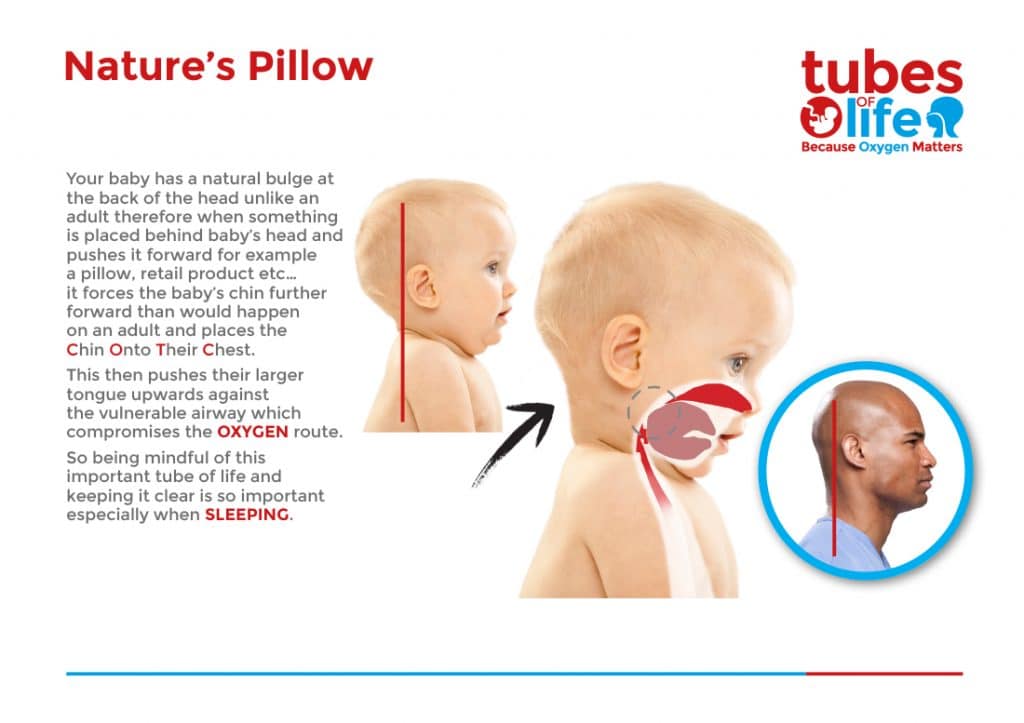
With this information we can now look at the impact of carrier heights. Many manufacturers emphasise a tall panel as offering "head and neck support", however this misunderstanding of baby anatomy with a focus on marketing can cause significant problems.
The traffic image below shows three carrier heights.
The red image with the cross symbol shows the impact of having a carrier that is too high for baby, or one that is too loose that baby can slump forward and sink down into. Baby's head has been pressed forward by the panel height, so their chin has sunk onto their chest. Their airway is compromised and they are at risk. This baby needs to be taken out of the carrier so they can breathe safely. The carrier should be adjusted to the appropriate height, or not used until baby is big enough. When babies sleep, their muscle tone relaxes, so they may slump into carriers that have become too loose from their active weight. If baby is starting to fall asleep, the carrier must be adjusted to ensure it is snug enough around them so they do not sink downward and end up with their head pressed forward by the carrier, and losing their airway.
The green image with the tick symbol shows the optimum panel height. The carrier is reaching to the nape of the neck and earlobes are visible. The baby's head is free to move from side to side and back and forth with no restrictions. Baby's chin is off the chest and airway is open for easy breathing. The chest is well supported against the parent/carer so baby cannot slump into a curved C shape, even if they fall asleep. If baby does slump with sleep, the carrier needs to be adjusted so it is snug and baby's chest is no longer curling forward.
The orange image with a question mark shows a panel that is low. This is not safe for a newborn, or a younger baby who lacks trunk and neck control, or one who is sleeping. They may fall backwards as there is inadequate support for their upper back. The panel will need to be adjusted to be long enough, reaching only to the nape of the neck. An older, awake baby may enjoy having arms out of the carrier for better visibility and engagement with the world. However they must have adequate trunk and neck support. In general, if a parent is able to perch their baby on their hip and support them confidently with one arm, that baby can be worn with arms out. As soon as they are showing signs of sleepiness, their arms need to be brought in and carrier adjusted to reach the nape of the neck for support, and to be snug around baby so they cannot slump.
What if my baby's head is floppy?
Parents often worry about a baby having a floppy head in the newborn stage and it is natural to feel the need to support baby's head. One hand to provide support when you lean forward or walk may be all you need, and babies will soon develop strength and co-ordination. The key thing for airway safety is to avoid forward slumping in a too-loose carrier. Looseness can cause wobbly heads, more importantly it can allow babies to slide and slump, so please check your carrier tension/fit and do not be tempted to raise the panel. Please visit your local library for support if you are struggling, we are all experienced at working with this issue and would be delighted to help.
Some people like to use the sides of a stretchy or woven wrap to provide gentle support to the back of baby's head while asleep, as in the image below.
This can be helpful if their face remains free of fabric on the other side, but it must be done with caution and alertness to any sinking of the head, or baby wishing to change the direction of their face. I usually recommend flipping the fabric to ensure a good line of tension to help with support, and ensuring an open airflow on both sides.
Some people will use a rolled muslin or teatowel tucked into the horizontal layer. If you do this please ensure it is a narrow roll to avoid inadvertently tipping the occipital bone forwards. The image below shows how the roll remains at the nape of the neck and the fabric is rolled outward so the muslin cannot accidentally fall inside the space occupied by baby. Chin is up and airway is open. This is not usually necessary if the carrier is snug across baby's upper back and they have a good pelvic tuck. Please see this link for more reading about the pelvic tuck.
What about buckle carriers whose panel is too long?
Some carriers have adjustable panels, which will help. For those that don’t, this is a challenge. Here is a video showing you how to raise baby inside a panel that is too tall (Ergobaby Omni 360 here). Do not be tempted to leave the panel too tall. See your local Iibrary if you are struggling, or wait till your baby has grown taller and the carrier now fits. Here is a photo tutorial showing you how to raise your baby inside a panel that is too long, if it cannot be adjusted.
My baby likes to face-plant!
This is not uncommon. Ensure good airflow on both sides of the face by flipping the shoulders of wraps and ensuring panel height is not too high up the sides. More reading here.
What if my baby has fallen asleep in the carrier on my back?
This can cause babies to feel loose and floppy and their head can fall backwards. This can often be rectified by adjusting their position and the snugness of the carrier. Children often loosen carriers by moving happily when awake, parents must be aware of this tendency and willing to adjust the carrier so airway is maintained at all times. See here for how to do this.
Facing out
Forward facing out brings its own challenges for an airway. Carriers that are too tall will cause pressure on baby's tender neck when facing out. This is especially risky if they fall asleep and their head falls forward with their neck compressed by the carrier rim. It is not safe for a baby to sleep facing forwards. Sleeping babies must be removed from the forward facing out position and turned around for safe sleep. Please see this link for further reading.
Feeding in carriers
Feeding in carriers must be done safely. For the above reasons, there should never be any fabric behind baby's head when breastfeeding, as their nose could also become blocked by breast tissue. Once the feed is over, baby must be removed or repositioned at an appropriate height on the hard upper part of the chest. Babies should not be left to sleep in a feeding position/height. Please see this link for further reading.
_________________
Link to image for sharing (and other resources) here.
Tandem Babywearing, or Carrying Multiples
So you've got more than one baby! Twins, triplets or more? Wondering about tandem babywearing (carrying multiple children at once)?“Is carrying them in a sling possible?” “Is it safe?”
“What sling do I need or want?”
“Where do I start with babywearing twins, or with carrying a toddler and a baby?”
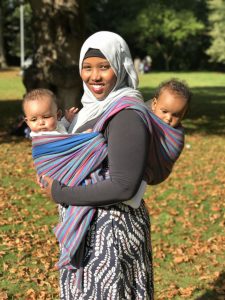
There is no doubt that carrying more than one child is one of the things that can baffle and inspire people at the same time, from the practicalities of it to the beauty of two babies in one sling.
Why carry more than one child?
When people think of carrying multiple children they often think of carrying both babies at once, this is called “tandem carrying” or “tandeming”, however, it is not necessary to tandem carry every time, or even at all! Being able to carry one at a time will free up your arms, meaning you are able to look after both babies at the same time, keeping one soothed while meeting the other’s needs.
This goes along with all the other many benefits to babywearing that applies to one child and their caregivers. More in depth information about all of these can be found in these articles here and here.
Babywearing can also be an amazing tool to use if you also have older children, to help engage in play with them whilst the younger babies are happily in the sling. There can be some limitations with this as it can be difficult to keep older children in check when tandem carrying, due to some of the movement /speed restrictions!
How does it work?
For new parents the idea of learning to use a sling can be daunting and especially for new parents of multiples due to the huge range in choice and the practical logistics of it. The best thing to do is to learn to carry one baby safely and with confidence first, then move on to tandem carrying when needed.
But how do I learn to use a sling?
There are so many ways to learn now from one-to-one support (if you are local to us in Sheffield, the Sheffield Sling Surgery bookings are here) to self-learning from online videos (do choose channels made by experienced and reputable teachers!)
One of the main benefits of choosing professional support and learning one-to-one is the hands-on and emotional support this service offers. This can range from learning your very first ins and outs of carrying your children, getting a fit check and some tweaks, to expanding your carrying knowledge as you begin to learn your preferences, all with a listening ear and an experienced guiding hand.
The most important thing is to ensure that you are carrying safely. Feeling safe and confident with professional support can be one of the most helpful inputs for beginning to develop that amazing bond with your child/ren.
Booking a consultation will help you to gain these skills. Consultants train with various schools of babywearing and they have a wealth of knowledge and experience in carrying children as well as teaching you the practical skills, they may call themselves babywearing or carrying consultants. They have a passion for carrying children and the technical knowledge to know how to carry in a variety of ways, and will support you in however you want to carry.
Laura; “I carried my first baby everywhere and anywhere so I knew I wanted the same when the twins came along but the idea filled me with all the anxiety! I booked onto a couple of consults and turned up at the drop in sessions at the library to nosey at and try out the styles.
When I first carried both babies I used the stretchy wrap which I was taught to use at a consult. We went through the basics first and got one baby secure then onto adjustments for twins. Each step was explained and I was helped to iron out the niggles to get them and me comfy. The consultation was invaluable! It made getting out and about so easy. Now they’re bigger I’m using all the slings and wraps thanks to more consults and guidance. I love babywearing!”
So what are the options when carrying multiple children?
There are a vast number of ways to be able to carry multiple children. Some carriers are designed to carry two children at the same time, others can be adapted to suit the needs of your family.
We will first look at the individual carriers that can be used in different ways to carry single or multiple children, then we will look at carriers that have been made specifically to carry twins. We’ll explore using two similar carriers to carry multiple children, and then lastly we will consider the mix and match approach of using different types of slings at the same time!
Individual carriers that can be used to carry one or both children
Stretchy Wrap

A stretchy wrap is a length of fabric, usually made of soft and stretchy machine knitted cotton, that is usually between 4 and 5m long and about half a metre wide. Some have bamboo blended in with the cotton, which adds to the softness and comfort, and some have a small proportion of spandex, which adds to their elasticity and stretch.
When choosing a stretchy wrap it is best to get your hands on a few different brands as they vary in stretchiness and therefore give a different level of support and comfort when two babies are being carried, due to the increased weight.
The best thing to do when preparing to carry twin is to get to grips with using the sling for one baby, usually the pocket wrap cross carry. Our photo tutorial for putting on a two way stretchy wrap in a pocket wrap cross carry (PWCC) with a single baby can be found here. Once you have mastered this, then you can learn to get both in at the same time (you will need to allow more space for both babies!)
However, when it comes to putting both babies into a stretchy wrap, it can be challenging to learn all of it from a video (many videos are best used as aide memoires once the skill has been learned). Furthermore, some twins may be under the recommended weight limits for the wrap, so it would be beneficial to get in contact with your local babywearing team and book some in person support with them to make sure that everyone is safe.
This is a beautiful video done by LeKeta Kemp from Tandem Trouble, it shows her demonstrating a pocket wrap cross carry for twins with a sturdy stretchy wrap.

Pros and cons of using a stretchy wrap for twins
Pros
- Once tied, a stretchy is a poppable carrier so can be put on at the start of the day and babies can be taken in and out of the wrap without needing to retie each time.
- It can be used for one or both babies.
- It can feel more affordable than other options.
Cons
- It can be hard to get the hang of it when you are first starting out, as there is when learning any new skill. However with practice it will soon become manageable.
- It can be harder for people with smaller frames and as babies get bigger.
- Some people can start to run out of space on their front with two babies!
Close Caboo
The Close Caboo is a hybrid stretchy carrier, the fabric is sewn into a pre-arranged shape (similar to a PWCC), which can be slipped on over arms and head, to offer two ready made hammocks for baby to rest in.
A Close Caboo can also be used with twins in the same way as a stretchy wrap. It has some of the structure sewn in, so is already partially set up for use. It has two pockets, both adjustable by tightening the fabric through the rings at the side, and then a third layer to tie over the top for security.
The advantage of the Caboo is that it can be adjusted to size, then popped on. With a few minor adjustments it can be used for either one or both babies, each pocket can be adapted to fit their different sizes. It is also really easy to adjust when the babies are in the Caboo, as the rings can be used to pull the fabric tighter if needed.
You can find our photo tutorial for getting one baby into a Close Caboo here. With two, each baby sits in separate pockets and they are placed in one by one, with the third layer tied on around both at the end.

Pros and cons of using a Close Caboo for twins
Pros
- The fabric is a one-way stretch – this can mean less of a slumping risk as babies get bigger and can feel sturdier.
- It is really easy to adjust when the babies are in.
- It offers a quick and easy front carry.
- It is easy to use and learn for one baby as well as two.
Cons
- The panels are thinner when compared to a stretchy wrap, this means it can be harder to get the position just right to avoid red marks at the knee.
- It is a little more expensive than a stretchy wrap.
Woven Wraps
A woven wrap is a fantastic tool for babywearing, it can be used in so many ways for one or two children of the same or different ages as well as being used alongside a different carrier. Essentially a woven wrap is one long piece of fabric that has been woven specifically to carry children, they vary in length, known as their size (most commonly from 1 to 8), and what length is used comes down to personal preference and what you are going to use the wrap for. You can find more information about woven wraps here.
A woven wrap can be used from the very start of your carrying journey with twins, either having both on the front (a front tandem carry) or one on the back and one on the front. If you are planning to do this then a consultation is needed to learn these skills. Back wrapping a small baby is a skill that takes a lot of practice in itself and requires professional support and guidance, and it is best to get to grips with front carries with the woven wrap first.
Front tandem carries
There are many options with woven wraps for front carrying two babies of a similar size until you run out of room! One of these options is the Jasmine’s Hip Carry which is usually done with sling rings.
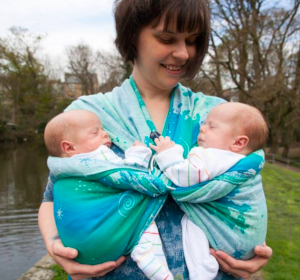
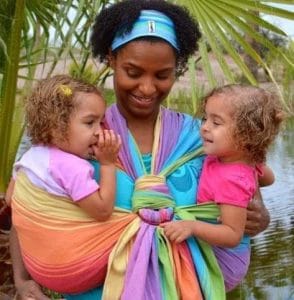
What makes it so special? The Jasmine’s Hip Carry is done using one woven wrap with either one or two rings. Once prepared the wrap can be left threaded through the rings so it is pre-tied and removed for wear at a later time, each side of the carry can also adjusted to suit the size of each baby. This can be tricky to master but lots of practice will help!
This video by LaKeta from Tandem Trouble is a great video to see the logistics of a Jasmine’s Hip Carry with two rings.
Other options are the Amanda’s Tandem Hip Carry,(from Tandem Trouble), which is a ringless carry that knots round the back. There is also a twin version of the popular Front Wrap Cross Carry (from Little but Once), this has no ring and is tied at the front or back depending on what size wrap is used.

Front and Back Tandem Carries
A front and back tandem carry can be used for children of the same or of different ages.
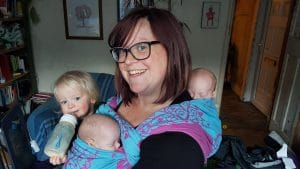
This is because woven wraps are a collection of individual strands meaning they can be carefully tightened section by section to ensure your baby is fully supported from neck to knee pit, with the airway open, respecting the natural gentle curved J and M shaped position. As these back carries tend to be done high up on the parent’s back, caregivers are able to see their baby’s face and feel their breathing on the back of their neck.
When back carrying a newborn, most people will choose a simple rucksack carry, which is just a single layer across the baby, ensuring there is less pressure for tiny bodies. However, getting your baby up on your back can be a challenge and is something that is best learned with the help of a professional. This video from Wrap you in Love will give you an idea of the safe way to do this if you would like to see how it works.
Once you have one child up on your back, you can use the rest of the long wrap, tied in a crossed across the chest ‘Tibetan’ finish, to pop your little one into the cross passes. This can also be done with two different wraps, mostly done when a toddler is on the back in a carry with multiple passes and a short wrap is used as a simple sling pass, passed through the wrap and tied under their bum, as seen below.

Doing a front and back tandem carry can be a lifeline for some parents. Life with small children can often feel very hectic and being able to keep both children close at the same time can be a fantastic parenting tool.
Anna Nham; “Solo parenting with a toddler and a baby and the older one refuses to walk home, or tiredness hits and everyone wants a cuddle at the same time. These are the moments I am grateful to be able to tandem carry my kids. There’s 19 months between my two and while I can’t say a tandem is an everyday occurrence, when both of them need some close time or both need to nap at the same time I am always grateful to be able to pop them both up and at least create a moment of peace for me. It was especially important when the baby was smaller and needed more contact. Allowing me to give the older one something familiar and make him feel like he wasn’t pushed out. Now he finds it hilarious when his brother is put on the front and he is on the back and loves to share that space with him. I definitely can’t get far with 24kg of kid attached to me but I can provide comfort and that’s an invaluable tool to have.”
Pros and cons for woven wraps
Pros
- They are very versatile for carrying one or two children.
- They can be used for front carrying both children, or for carrying one on the back and one on the front.
- They can be used with children of different ages.
- They can be used from birth to the end of your carrying days.
Cons
- They can be difficult to learn, but once you have gained the knowledge of how the fabric like to move then it is an invaluable tool .
- They can be hard to get the right fit every time due to the way they are tightened and deal with a feisty child, but with patience and practice you will get it.
Carriers designed specifically to carry twins
These carriers have been made with the needs of twin parents in mind and are focused on easy carrying of both children at the same time. They can be expensive, due to the complexity of the engineering (even if they are simple to use!)
TwinGo
This is a fantastic buckle carrier and one of the best known twin carriers around. It gives caregivers the option to carry two children at once, either twins or children that are close in age as it is designed to have one child on the back and one on the front.
It can also be split into two individual carriers meaning that you don’t always have to tandem carry. Here is a demonstration video showing how to use the TwinGo with two children.
One limitation of the TwinGo is that the panels aren’t adjustable in height or width. This means that it is best used when both children are big enough to fit in the panel knee pit to knee pit (normally around 5-6 months). There are newborn inserts, but inserts can be fiddly when used and cannot be used for a back carry. We recommend trying the TwinGo out before you buy, as the whole bundle can end up being expensive.
Pros and cons of the TwinGo
Pros
-
- It is ideal for carrying two children of the same/similar age with one on the front and back.
- It is designed specifically to do this, so it works very well.
- The padded straps and waistband add comfort even with heavy children.
-
- It can be used as two separate carriers for different caregivers if needed.
Cons
- It can be fiddly using inserts until babies are big enough.
- It cannot be used for front tandem carries, only front and back.
- It can only be used as a front and back tandem carry for babies four months and over, when they have reached the 3 milestones defined by TwinGo. More details about these can be found here.
- It is expensive.
The Weego
This buckled carrier is designed to carry two babies of the same age on the front only. It has two pouches that are adjustable with poppers on the inside to give the correct panel height (size) which means it can be used from newborn till around 6 months (or 15kg combined weight.)
Below you can see images of the popper system in the Weego, followed by images of the configuration of the pouches.
Here you can see the inside of The Weego with all the possible placements for the poppers (A&B). You can also see the zips used to close each individual pouch (C), as well as the zips to secure the final layer of the sling around each baby (D).
An amazing article going into full detail about the Weego can be found here. It was written in 2019 by Joe Rawlinson, a dad of twin girls. It is a detailed and honest review about the Weego and how it helped them as a family with newborn twins.

Pros and Cons of the Weego
Pros
-
-
- Each compartment can be sized for each individual child.
- Both children can be carried on the front at the same time.
- Can be left already prepped so no need to re-do the internal poppers until babies have grown considerably.
- One baby be left in while the other is removed. This can be very useful for nappy changes/feeds etc.
-
Cons
-
-
- It can be fiddly to get right.
- It can feel bulky when on the front with both babies in it.
- It can feel heavy due to the narrow, flatter shoulder straps with no waistband.
- It is expensive.
-

The MiniMonkey Twin Carrier
This carrier is designed to carry two children of the same age, on the front only. It is made up of two pouches for carrying babies in an upright position, mimicking a Jasmine’s Hip Carry in a woven wrap, but with the added support of a waistband. The ability to move the position of the pouches along the waistband can be very helpful to get an optimised and more comfortable position for both the wearer and the children.
The MiniMonkey Twin tends to fit babies best when they are about 4-5 months old, as the pouch height can be more challenging to adjust for smaller, newborn babies. This can be done with support from a consultant. Many people find that the Mesh MiniMonkey is easier to use with smaller babies as the material is thinner and easier to tuck for adjustments. Still others find that using two individual MiniMonkey carriers together on either shoulder across the body can be a more comfortable (and cheaper!) way to carry two babies together.
Here is the instruction video.
Pros and Cons of the MiniMonkey Twin
Pros
-
-
- It is a carrier that is prepared in advance, making it simple to put on each time.
- Each pouch can be adjusted for each individual child.
- The spreadable shoulder straps offer more comfort.
-
Cons
-
- It can be more challenging to use for newborns.
- The height of each pouch cannot be adjusted so if babies are too small then they may get ‘lost’ in the pouch. This can be overcome with support, or using the mesh version.
- It is expensive.
Using Two Matching Carriers
There are many ways of using two individual carriers to carry multiple children, either the same or different types of carrier. A lot of these combinations are learned through trial and error to find out what suits your family best.
Two Meh Dais and Half Buckles – A Meh Dai (also known as a bei dai, formerly known as mei tai) is the common name given to a type of Asian carrier that originated in China many years ago. It consists of a fabric panel with long straps that are wound around the parent’s body, to be tied or twisted or tucked away securely. Different cultures have their own variants of these cloth carriers. A half buckle is the same style with the panel and woven wrap straps, however instead of being tied at the waist there is a buckle fastening.
Front Tandem Carries
There are two main ways of using Meh Dais to tandem front carry. This first is that both are used in a standard front carry but both children are held off centre (this can be seen demonstrated below) by Drew Joseph or by doing two hip carries. These can be tricky to master, but practice helps!
With two half buckles the same methods can be applied, however there are also a few brands (such as Didymos Didyclick and Mamaruga Padma) that can have two panels attached to the same waist band. The advantage of this is that there is only one waistband being used, reducing bulk, but you still have control of placement of the panels.
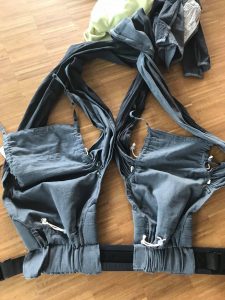
Images from Rosie Knowles (of LaKeta Kemp using two DidyClicks)
Front and Back Tandem Carries
Meh Dais and Half Buckles can also be used to carry two children, one on the front and one on the back. It is possible to tandem carry this way from a few weeks old. However, it can be scary and challenging to get a small baby safely on your back alone, just as with a woven wrap, so it is best to get professional support and guidance with this.
Pros and Cons of Meh Dais and Half Buckles
Pros
- They give the comfort and feel of woven wraps but with the convenience of a pre-made panel and the comfort and security of a waistband.
- Two carriers can be used for both front tandem carrying or front and back tandem carries. Each carrier can then be used individually as needed or by two caregivers.
- Meh Dais and Half Buckles can be used for a front and back tandem carry from newborn, with professional support.
Cons
- It can feel like a lot of fabric in one place with 4 straps being wrapped around you and two waistbands.
- There can feel like a lot of knots if using two carriers at once.
Two Ring Slings / Two MiniMonkey MiniSlings
This is a nice option for when you would like to have two individual carriers that can also be used at the same time. Two ring slings offer a front tandem carry like a Jasmine’s Hip Carry, however with two pairs of rings pressing against you it can dig in a bit. Some caregivers deal with this by placing the rings on the back with a flip in the fabric on the front, this can work well with practice but often involves a learning curve. Using two individual MiniMonkey MiniSlings can be a lot easier, it mimics the double front carrying option of the Twin MiniMonkey and works well for small babies. With heavier and older babies, the waistband of the Twin MiniMonkey can be useful for better weight distribution.
Pros and Cons of two ring slings or two MiniSlings
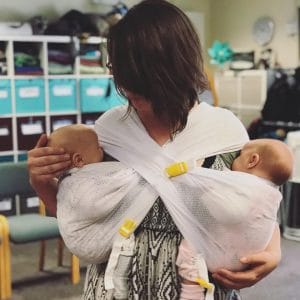
Pros
- Using two separate carriers means there is always the option of carrying one child at a time (or each if there is another caregiver).
- Two MiniSlings is a great hot weather option.
- Ring slings can give more adjustability than two MiniSlings.
Cons
- Two sets of rings can be hard work to adjust easily and be uncomfortable.
- The first baby can end up sliding under your armpit when putting the second baby in, but this does get easier with practice.
Two Buckle Carriers
There is a wide variety of buckle carriers that can be used when doing a front and back tandem carry when one baby fits well into the panel and is almost able to sit unaided. It always helps to explore all the different types of buckle carriers and see what would work for your family, as one type does not suit everyone. You may even choose to use different brands together.
Front tandem carries
There are a few buckle carries that can be used together for a tandem front carry, either off centre or hip carry. These are the Integra, the Ergo Embrace and the Izmi, as these have unpadded waistbands so there will be less of a large bulk around the caregivers middle. However, this can become very fiddly with all of the buckles and the straps across the shoulders. We would recommend booking an appointment with a consultant to make sure everyone is safe.
Front and Back tandem carries

Most brands of buckle carriers can be used for front and back tandem carrying, however it may be more comfortable to choose two with unpadded waist bands, for (example the Integra or the Izmi) as they will sit flat against the waist without too much bulk. Another option would be to use one unpadded and one padded waistband (for example a Tula or Lenny Lamb). This still keeps bulk to a minimum while increasing the feeling of support. There are so many variations you could use, so it is best to have a good look around and see what types of buckle carriers you think would suit you. Most sling libraries will stock a good range for you to try out.
Pros and Cons of two buckle carriers
Pros
- Two carriers offer a lot of adjustability.
- Each carrier can be used to carry children separately (sharing the load between caregivers, or if one child is in the buggy/walking!)
- Some carriers work well in combination.
Cons
- Two carriers can feel very fiddly with lots of buckles and straps.
- Carriers that have fixed position panels can be hard to move around the waist for two hip carries.

Mix and match options
Sometimes the best option is just to choose the things that work well for you on their own and see how it goes! The possibilities are endless when it comes to the mix and match approach, from a woven and a buckle together, to a Meh Dai on the back and a ring sling on the front.
Mix and match is often the easiest option when carrying children of different ages, making the most of the slings you already have. For example, a stretchy wrap or a close caboo is a fantastic option to use alongside another type of carrier when caring for a newborn baby and a toddler. The stretchy/Caboo should be put on first of all, and adjusted to fit the newborn snugly and safely. Baby is then taken out, leaving the stretchy/Caboo in place. This frees you up to then get your toddler safely onto your back in your chosen carrier (eg a woven or a buckle) without worrying about your baby during the process. As the stretchy/Caboo is “poppable” and has already been set up for your baby, once toddler is in place, baby can be quickly and easily popped back in (or out again, as needed, eg for a feed, or if your toddler has fallen asleep and baby needs a change or some play time).


Pros and Cons of mix and match tandem babywearing
Pros
- There are many possibilities and a chance to be creative.
- This mix and match method can be very useful for using the slings you already have, rather than needing to buy more.
Cons
- It can feel like an overwhelming amount of choice; this is where sling libraries and consultants can offer guidance and get you off to a flying start.
Many families will opt for a sling and buggy combination with two or three children, but it is in fact possible to carry three children at once, as this hero mother demonstrates!
Summary
The most important thing to remember if you are considering using slings with your children, is to do what is best for your family. This will vary. It could be carrying children individually, one in a sling and one in a pushchair, or it could be tandem carrying. Every family is different, so what works for you might not be the best option for the next family, and what works for your friend might not be best for you.
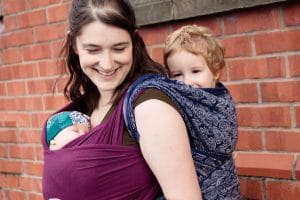
In conclusion, we recommend becoming familiar with carrying one baby first and then progress to tandem carrying in whichever way you feel most comfortable with. If you are unsure about anything, get support from a trained professional, they will be more than happy to give you all the information they can (we love to do it!) and do their utmost to make sure that you are utilizing all the resources that you can.
Authors Jess Yarborough and Rosie Knowles
Babywearing and Prolapse (guest post)
Pelvic Organ Prolapse is common, and can make babywearing complicated. Here is a super post from Nelly Brewer at Forest of Dean Slings on this topic.
Original post by Nelly Brewer can be seee here
🌸 BABYWEARING AND PROLAPSE 🌸
A personal perspective
Pelvic organ prolapse, where one or more pelvic organs bulge into the vaginal cavity, affects A LOT of people who have given birth. If you’ve been diagnosed with, or suspect you may have, prolapse, you may be wondering if it’s safe to carry your baby in a sling or soft carrier.
The answer is – probably! I discovered my prolapse 3 weeks after my first child was born. I’m not a medical professional, but I have gained a great deal of personal insight over the last few years into managing prolapse symptoms, and how to combine this with safe and comfortable babywearing. Below are my thoughts on carrying and prolapse based on my own journey.
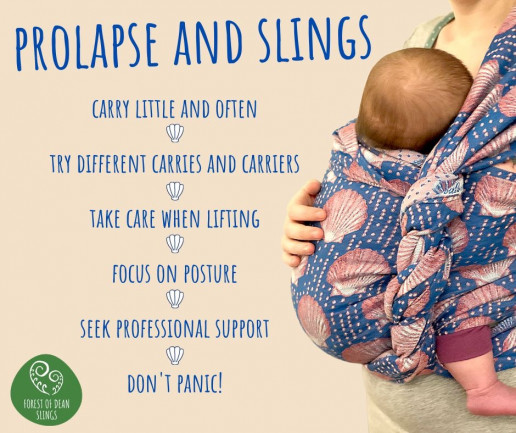
🌸 Carry little and often 🌸
It’s super disappointing to not be able to go on a 4 mile walk through the woods with your newborn. I’ve been there. It sucks. But carrying little and often in a well fitted carrier can help build core muscle strength while reducing further damage. It’s very easy to overdo it, so if you do have a day with a lot of carrying, try to rest the following day. It’s OK to feel frustrated by these limits. Be kind to yourself while you adjust your expectations of your postpartum body.
🌸 Try different carries and carriers 🌸
Carriers are like jeans – different styles suit different wearers and there is no ‘one size fits all’ carrier – whatever the box might say! It’s a good idea to visit your local sling library to try out some different styles, or book a session with a carrying consultant to explore as many options as you can.
Some people with prolapse dislike buckle carriers with firm, structured waistbands, which can constrict and put pressure on the lower abdomen, especially when combined with poor posture. Buckle carriers with less structured waistbands, meh dais and woven wraps might be a better option for some wearers.
You may also find that hip or back carrying places less strain on your pelvic floor than front carrying, particularly when using a carefully tightened woven wrap. Most buckle carriers are suitable for back carrying from around 6 months. Woven wraps can be used for younger babies, but you may want to seek support from a trained carrying consultant before you do so.
🌸 Take Care when Lifting 🌸
Heavy lifting, pushing and pulling is not good for prolapse. Always engage your pelvic floor and breath out when lifting your baby (or anything else!). When moving your baby onto your back in a carrier, a hipscoot or seated lift may be a better option than the ‘superman toss’. Avoid carrying your baby in the car seat wherever possible. A carrier is a much better option for getting your baby to and from the car, and taking them round the supermarket, to baby groups or the health centre.
🌸 Focus on Posture 🌸
Existing poor posture may be exacerbated by the extra load of a baby in a sling, putting extra strain on the back, core and pelvic floor muscles. Paying attention to your posture and taking steps to correct it can help with managing prolapse symptoms both with and without a baby in a carrier.
🌸 Seek professional support 🌸
It’s a good idea to seek support from a trained carrying consultant to help you find a carrier that works for you. It’s also a good idea to seek professional support for your prolapse symptoms. This could include physiotherapy sessions with a women’s health specialist, a low intensity exercise programme focussing on core and pelvic floor strength, and the use of a silicone pessary to support your pelvic organs. In the UK, your GP will be able to signpost you to available NHS services. Be persistent if you’re not offered the support that you need!
🌸 Don’t Panic! 🌸
Prolapses that develop soon after birth have a good chance of improvement even without treatment, but it can take a couple of years. The body produces a hormone called relaxin during pregnancy to loosen the ligaments in the pelvis, and relaxin levels can take a while to reduce after birth, particularly when breastfeeding. It can be really hard to be patient, but hang in there! However, even if your symptoms do go away, it’s important to continue to protect your pelvic floor health.
Further reading about carrying with a postnatal pelvic floor can be found here.
Top FAQS
These are the most common questions about babywearing I am asked, in a single helpful list!
Just click on the links to read the relevant blog posts, some are kindly shared from others
Firstly; some of my most popular articles:
Do the babywearing “rules” really matter?
Babywearing and infant mental health
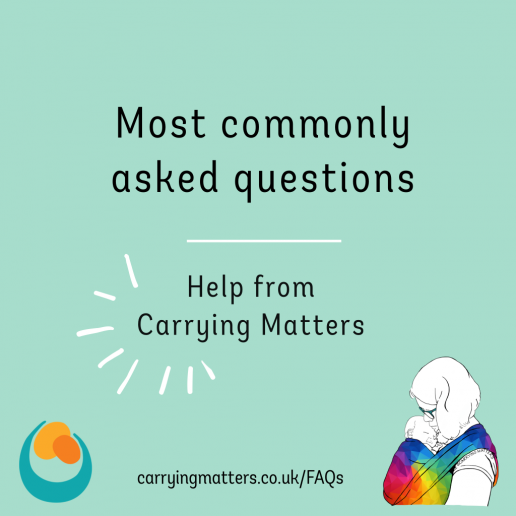
Secondly, I get this query daily. “Can I use your infographics to support families?” ABSOLUTELY! Everything on this website was created to help families with children to feel close and connected. Please credit me appropriately and link back to my website/social media (facebook, instagram)
Here is the link to the infographics (eg the Fourth Trimester/Build a Happy Brain/Why Carrying Matters/Skin to Skin posters, safe carrying images and much more)
Here is a search box to help you find what you’re looking for.
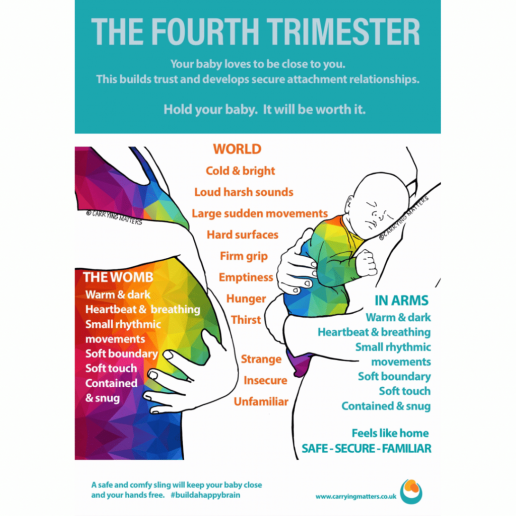
Getting started, and learning the basics
What kinds of sling are there and how do I use them? (links to the major types with useful guides, videos and troubleshooting)
How do I keep my baby safe in the sling?
Babywearing with a Newborn
What are the benefits of babywearing for my baby?
Are there any benefits for me too?
What are the best newborn sling options? (Coming soon)
How soon after birth can I carry my baby and what if I have had a Caesarean Section?
My baby’s head is so wobbly in the sling!
How high should my carrier be?
Can I carry my premature baby?
How do I protect my postnatal pelvic floor and babywear?
What about if I have a prolapse? (Thanks to Forest of Dean Slings)
Help! My child cries in the sling!
Does babywearing help my mental health?
Are slings useful if I have a perinatal mental health challenge?
Carrying in different circumstances
Can I sleep while my baby sleeps in their carrier?
How do I carry more than one child at a time?
How can I carry safely in hot weather?
How do I keep my baby warm while carrying in the cold? (ie can I put them in a snowsuit?)
How do I keep myself and baby dry when babywearing in the rain? (Coming soon)
Carrying adopted or foster children
What if my child has a disability? See this link for a stories from families living with a range of specific conditions.
Common safety queries
Will my sling hurt my baby’s hips?
What if I fall while babywearing? (Coming soon)
Sling Fitness/Dance and Babywearing
There are many fitness or dance classes focused on maternal wellbeing and bonding with baby while babywearing, which can be a great thing to participate in, like Barre and Baby, Dance Like a Mother, Joiemove and Sling Swing, to name just some.
We all know babies thrive when close to their mothers, and baby carriers can help with this rather than putting babies down all the time. Movement and activity are known to lift the mood, and friendly, welcoming social activity is an important part of helping new parents find a supportive community so they feel less alone. So keeping babies close during a fitness or dance class may seem to be a match made in heaven… or is it?
Some classes market themselves by suggesting that new mothers should be trying to “get their body back” shortly after birth, so they feel good about themselves. I dislike this phrase; after all, why would you want to encourage a butterfly to revert to a caterpillar? Motherhood and the changes that come with it are to be celebrated. Many women would like to work on the strength and health of their bodies, but this should be a positive choice, not one made out of shame or embarrassment.
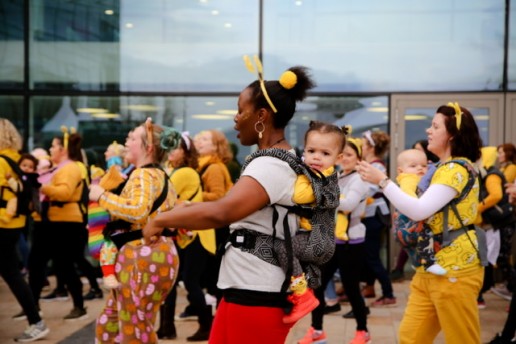
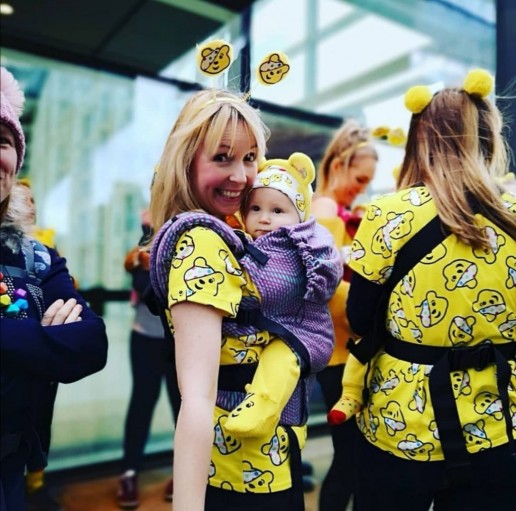
Baby safety at all times, and the health and wellbeing of new mothers are both of vital importance. It is my firmly held belief that anyone who is suggesting or recommending the use of a carrier during a class should be competent and confident in their use. This can only come with adequate training.
Furthermore, I believe that the long term health and fitness of women after birth and pregnancy takes precedence over quick-fixes. The pressure to “get your body back” and the media focus on celebrity bodies is not helpful for women. Good mental health and a supportive community are cornerstones of adapting successfully to life as a mother, and for many being active is part of that. However, there is often a significant lack of knowledge about the effects of many activities of daily life, let alone exercises or running etc on the pelvic floor, and loading it further with a baby carrier (especially one that is poorly fitting and uncomfortable) is detrimental in the early weeks to months.
It may take six months to a year for the body to recover completely, (according to research at Salford University). Of course this is very individual, depending on previous levels of health and fitness, how pregnancy and birth went, etc. Some women will be much more ready to return to their previous levels of activity than others. The “six week check” by the GP is often used as a benchmark to “sign off” as fit for exercise or dance classes. However, this is not what the six week check is for and this is not an appropriate way to establish if women are ready to return to increased levels of activity.
You can read more about my thoughts on slings and exercise here.
I believe that in order to be able to offer dance or exercise classes safely and beneficially, all instructors should be focused and committed to the health and wellbeing of both the mother and the baby as their top priority.
Instructors should all
- Have formal, high quality and officially recognised postnatal training qualifications (requiring assessment, and willing to provide these credentials to parents who ask.)
- Have a significant depth of knowledge on the pelvic floor after birth and the effects of certain movements and activity on this recovering organ. This is often lacking. I recommend the courses for fitness professionals run by Louise Field of Adore your Pelvic Floor.
- Offer proper assessment of a mother’s functional strength (beyond the “six week check”) and a willingness to adapt movements to reflect this.
- Demonstrate the ability and commitment to put the client and baby’s needs first, even if it means saying that the class isn’t suitable. Babies are not an accessory to be used for fitness.
plus
- High quality, in depth babywearing peer supporter training to ensure mothers and babies are carrying safely at all times, without any compromises. Instructors should have a particular interest in babywearing for its own sake, as opposed to something to add onto existing classes. Ideally they will already be familiar with slings. They should demonstrate a keen desire to be practising optimally and in line with current best practice. Baby and maternal safety is always paramount.
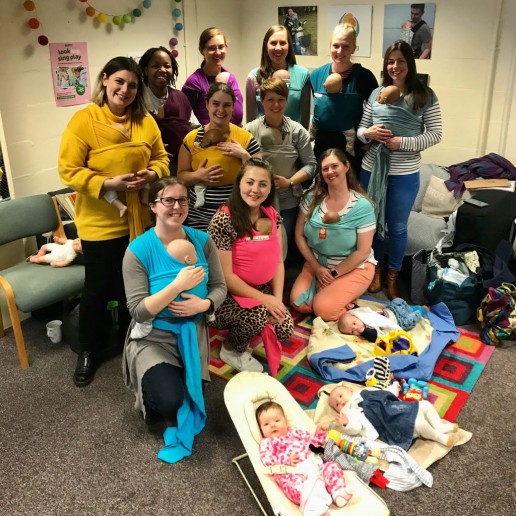
If you would like to explore the option of peer supporter training, please contact me to discuss. I reserve the right to decline training.
Please note that training with me is NOT an endorsement of any class, and Carrying Matters is NOT and never has been affiliated in any way with any fitness or dance classes.
I am no longer able to offer half day “safety awareness training” courses to those who are running postnatal fitness/dance classes. After a while running these courses, I feel this insufficient time to cover all the issues in enough depth to ensure the safety of babies and their mothers. This is especially as babywearing is not usually the main focus of the class and many class instructors have hardly any personal experience with babywearing themselves. Anyone who sees babywearing as an integral part of their class will be willing to invest in in-depth training with assessment.
Please note that I have attended a full day of training in pelvic floor awareness for fitness professionals myself.
Photo tutorial for raising baby up in a too-tall panel carrier to ensure free airflow
This tutorial shows raising baby up inside a panel carrier when the panel is too long, ensuring good airflow and free movement of the head.
This is important, as young babies have a large occiput (the round bone at the back of the skull) and if this is under pressure from behind, the head will tip forwards, pressing baby’s chin onto their chest and downwards into cleavage, which can present an airway risk. The fabric should never come higher than the bottom of baby’s earlobes, so they can move their heads freely. All the head support should come from the upper back part of the panel.
Help! My child cries in the sling
"Help! My child cries in the sling... she seems to hate being put into it..."
This is a frequent worry faced by many parents when they try out a baby carrier for the first time - either the very first sling they have ever used, or when trying to find something more suitable or comfortable for their child's needs as well as their own. I've come across many parents who are concerned that their child unfortunately hates the carrier they have spent money on, or convinced that there is no sling out there that will suit their baby as they always cry when they are put in.
Fear not - it is very common for babies and toddlers to fuss and cry and wriggle in slings, especially when it is a new experience, and my advice to parents in these circumstances is "don't worry, this is very common, you are not alone" and "yes, there are solutions". Crying in slings is common.
So why is it my baby cries as soon as I put her in a sling?
I think the key thing in such situations is to try and understand the experience the child is having - to put yourself in their shoes (or booties!)
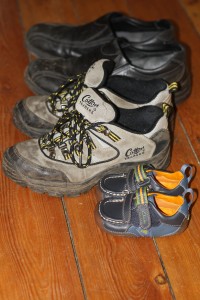
Being able to see things through a baby's eyes can often explain a whole host of issues - babies are small people with feelings just like adults, and they express these sensations in the more limited means they have at their disposal - laughing, wriggling, crying, bouncing, sucking, moaning, yelling, chewing, rooting, leaning, twisting etc. Being able to read and understand your baby's cues is vital to a good relationship and this is one of the benefits of a carrier; parents and carers are usually much more aware and rapidly responsive to a child who is close to their bodies and visible, as opposed to one who is detached and in a pram or a bouncy chair or a play gym etc. So it is good, your baby is protesting, he/she is communicating with you and you are aware of that! Now to meet the need he/she is expressing and thereby solve the problem.. The sling itself is usually not the cause of baby's displeasure.
What does your baby need?
- Is your baby too hot? (it is common to get very warm in a sling quickly. Your own body heat next to a baby's with the extra layers of the sling will bring their temperature right up, and we all know its unpleasant to be sweaty and over-dressed.
- Is your baby thirsty?
- Is your baby hungry? It is always worth making sure your baby is well fed before wyou embark on a new experience - and come armed with bottles, snacks etc to satisfy any hunger. It is usually worth meeting this need rather than ignoring it, as babies won't understand your priorities and will just continue to be upset. If you’re learning how to use the sling with someone, they will be more than happy for you to feed your baby - you are more likely to be able to absorb information when your child is happy. You can talk while feeding and still learn and you will always be able to try the carrier again later! Babies who are breast-fed may need to feed often, and few will refuse food that is offered, even if they've just been fed. Bringing a baby close to a chest full of milk will often create a desire to be fed, or to suck, even if tummies are full.. if you were a baby who could smell milk and were being held in a position where you couldn't reach, it would be maddening, and you might kick, or wriggle, or yell.) If your baby seems to be burrowing down, or chewing their fingers, or shaking his head from side to side, could that be a cue to be fed? Perhaps you can learn to feed in the sling?
- Does your baby have a sore tummy or is he too full of food to tolerate pressure on his tummy, just like an adult after a large meal? A seated sideways carry may be more comfortable.
- Is your baby wet or dirty, and therefore uncomfortable, or are they needing to eliminate? Babies are very aware of their own bodily functions.
- Is your baby tired? Many babies have a fussy period before they go to sleep. You may already be aware of this tendency in your baby when they are falling asleep in bed, in the car, in the pram etc, the sling is no different. A baby may learn that slings often mean sleep and if he doesn't wish to sleep, may protest. A little rocking with baby in sling is usually enough to help them drift off. Sometimes the new experience of trying a sling can be too much stimulation for a weary baby and push him over the edge from tiredness to tantrum, just as it would if you tried to feed him, or change his clothes. A good guide is two new things in a row (so at a sling meet, just try two things!)
- Is your baby in pain? Teething can be uncomfortable; distraction by play is a great tool, and if a baby suddenly has less distraction he may become aware once again of the ache in his jaws. Abdominal distension from constipation or sore genitalia may affect carrying.
- Is your baby responding to how she is being handled? Primitive reflexes like the Moro reflex (that causes the limbs to spread wide and then grasp) or the Tonic Labyrithine Reflex (over-extension, ie back arching due to an unsupported backward-lolling neck) can make babies feel insecure and unwilling to settle into a sling. Lifting and holding your baby securely from both the upper body and below the bottom can help to calm them before moving into a carrier.
- Is your baby responding to how you feel? If you are anxious or irritable while handling your baby, he will pick up on your muscle tone, shaky breathing and jerky movements and become distressed as something feels wrong. Sometimes it is better to just try again later when you are in a better frame of mind.
- Could you and your baby have some difficulties connecting, due to such circumstances as a complex pregnancy or a traumatic birth history (regardless of the objective outcome)? A lot of your unspoken feelings about your unborn baby and how your child arrived in the world can significantly affect bonding later, as can prolonged separation in the first few days or weeks of life. The rate of post-traumatic stress disorder after birth is surprisingly high (up to 9%) and there are several studies that demonstrate that such stress can impair bonding. This could be because of prematurity or illness, it could be due to feelings of guilt that are hard to shake off, even if they aren’t justified. Family dynamics and expectations, especially if they are in conflict with deep biological feelings can also have effects on how babies are handled and responded to. Babies are very sensitive to the feelings of their carers and will react accordingly - your baby’s behaviour and distress could be a signpost to some of your own internal discord and pain. This is where midwives, postnatal doulas and the NHS Afterthoughts services etc can be very helpful indeed in guiding families to find resolution and healing and I do recommend getting some support if you think this may be you.
In summary, if you and your baby are feeling good before you start, you are likely to have a more positive experience, and the more positive associations that are built up, the sooner your baby will begin to trust, enjoy and even ask for the carrier!
What is your baby's personality?
This is an important aspect. I often meet people who almost expect their babies to become utterly still in a sling, and to remain very calm. Well, after all, they're being carried close now, in a giant hug. What's not to love? What's not to be happy about??
Well, not everyone appreciates all-over cuddles, especially if they are not tired, and if they want to be active. This is where understanding your baby's personality may be very useful... imagine you were playing happily and patting a colourful thing in front of you. All of a sudden you are lifted up and wrapped knee to neck in a giant warm bandage, or suddenly put into a carrier, possibly one where you can't see very well. Some babies may love this; and settle down to happy drowsiness (usually because they are ready for cuddles, or are familiar with a well loved sling). Others may enjoy the sudden change of height and scenery and being able to smell their carer. Others may feel annoyed at being taken away from their happy activity, or be cross about not being able to see, or feel too hot, etc and don't appreciate the abrupt change - these babies may strain and bounce and wriggle or cry in protest. Most children I meet are pretty active in some way - and it would be unreasonable to expect them to suddenly change from an active, inquisitive personality into a more docile, still and placid one, especially if the parent also stands strangely still, with their muscles all tense with anxiety about the use of the carrier and if baby will like it. "Mummy doesn't feel right, she's not soft and relaxed - this isn't good."
Remember as well, where is your child in their natural sleep-wake cycle? The more you're able to understand your baby's cues as they express themselves the more likely you are to be able to meet these needs before they feel they have to cry to be heard.
Tips to help you and your baby get used to a sling together
Practice makes perfect
Get confident with a demo doll first. Sling libraries and sling consultants are usually well stocked with weighted demo dolls which will allow you to figure out how to use the sling safely (remember the TICKS guidelines) and confidently. If you are very unsure while using the carrier, your baby will pick up on your nervousness and become unsettled.. this applies to every kind of carrier. This is why I always encourage people who come to me for help to use the dolls first, even if it feels like it will take longer... in the long run it will be more productive as you will have figured out which bits go where and how to tighten that section, so when it comes to trying it with your own child, you will be able to concentrate more on your child and how they are finding it, than simply getting it on. Even a teddy will help if you don't have access to a demo doll. It's the preparation (for example, knowing how to keep a child high on your body while you bring the panel up smoothly, or having a ring sling already set up can make a world of difference to the speed at which you can get the carrier on before your baby gets fed up!) Most babies will only tolerate a few "tries" with a sling, two, three at the most.
- Use your carrier daily, for you both to get used to it, even ten minutes at a time, building up gradually.
Involve your child in the whole process
- If possible, choose a time that baby is likely to be receptive to the sling; if she is fussing as she is experiencing an unmet need, the sling may not be the answer and merely exacerbate her cries.
- If baby is happily playing, do respect that, and don't just snatch her away from her delighted learning. We'd feel a bit put out if someone just removed us from the middle of our day jobs to be cuddled - and for children, play is indeed their "work." Sometimes you may not have a choice (eg school run time!)
- If the time is right, engage your baby during the process, make it fun!
- Tell her what you are doing and make the process of being put into the carrier enjoyable in its own right. A toy, a teether necklace, a song. Rock or sway while you go through each step, and take your time - there is no reason why you can't stop halfway to go and show your baby her reflection in the mirror, for example, before carrying on. Babies have not yet learned how to be patient - they may spot a toy and want it at once - being denied the opportunity to get the toy can be frustrating and lead to wriggling.
Be caring and careful
- Observe how your baby likes to be carried in arms. Does she prefer hip carries? Does he love piggy backs? Try to reproduce this as far as you can. Babies are often "nosy" in the 4-8month period, and ring slings or hip carriers can be a brilliant way to carry a baby to meet their need to be inquisitive! Their preferences will often change as they grow. Try arms out for babies over 4months - freeing the shoulders can make a big difference!
- Check your baby is safe
(keeping his airway open and his breathing unobstructed is vital) - see link for more information on this
- Check that he is comfortable - if something feels wrong or hurts him, he will let you know somehow. Understanding how to create a comfortable position that allows deep relaxation is important. We all shift our positions without thinking during the day (eg recrossing legs, pulling up socks) and it is hard for a baby to do this as easily. We must be caring and careful. So familiarise yourself with the ideal M shape pelvic tuck position (knees above bum with pelvis tilted inwards) which will avoid any strain on the joints and allow a comfortable curve of the spine. Such a shift from a previously "splatted starfish" position to a hammock-shaped seat can really help. Ensure baby can move her legs freely at the knee (make the carrier narrower if needed) and no red marks are developing (raising the knees up can help with this problem). Babies should have free and easy access to their mouth with their hands for sucking or exploring. Check that fabric is not digging into baby's neck (a muslin roll can help here) and that any knots, webbing or buckles are not pressing on baby's body. Ensure baby feels secure, but not restrained or restricted (too tight carriers, or too large carriers, can pose problems of their own).
Keep your baby occupied!
Remember that your baby still wants to experience the world even while carried, as they do when playing on your lap or on the floor. Help them to be able to see a little, in a way that is appropriate for their age and still respectful of growing spines and hips. A carrier that has straps or fabric that comes close to the face may be irritating (do remember that babies grow taller, and many carriers can be adjusted to ensure faces and heads not obscured). Make sure that there is some activity going on - we all know about the sway we do to settle babies when carried in arms, and how often we shift them around, or the rocking/pushing of the pram - this gives a child some sensory input, rather than remaining still. I often encourage parents to go for a short walk round the block when they have just put a sling on with their baby - the motion and movement to get out of the house and the fresh air and change of scenery usually works wonders and parents come back with happier babies. Of course, once the parent is standing still again, and baby is bored with the reduced activity, he will protest!
Keep going!
Learning a new skill can take a little time and effort... both for you and for your baby. New experiences need to be absorbed and processed.. and every day is a new day, we all have off days, babies as well as their parents. If your baby cries in the sling, try using your carrier a little bit every day, for walks or participating in safe but engaging activities.. and bit by bit see if it gets easier and your baby becomes happier. The more relaxed and confident you are, the more your baby will respond to that (just like anything in life.) Don't force it, take your cue from your baby! If after a good go, things still don't feel right, try another one from your local sling library, and ask your friendly consultant/peer supporter to check your positioning - this is the best way to work out what carrier will suit each unique parent-child combination, and will save you money in the long run (you won't buy a carrier that doesn't work well!)
There are so many great things for you and your baby to gain from being able to use a sling - it is worth a little perseverance to get your carrying journey off to a great start, and hopefully this will be the beginning of a long and happy shared experience together!
Slings and Adoptive and Foster Families
We all know how vitally important it is for children to build secure attachments with their primary caregivers, both for a sense of security and belonging now and in the future. It is much harder for this supportive relationship to develop when the primary caregiver has difficulties of their own, and when children need to be taken into care. The adverse experiences being endured by children in these circumstances have been shown to have a long term effect on future mental and physical health
This page collects some of the most useful writing on the topic of sling use among adoptive and foster families.
Adoptive and foster parents will know that their children need all the love they can give; and a sling can play an useful part in building these bridges amidst the turmoil. The biochemistry of creating a secure attachment is not a conscious process, or one that depends on ancestry; the release of oxytocin and the down-regulation of the stress response that happens with consistent, close and loving contact happens in the background.
There are many other benefits in terms of language acquisition, socialisation, and also helping children to learn which of the adults around them are their primary caregivers.
Sue, a foster parent in the South, is a strong advocate of using slings as part of her care.
“Many of the babies who we care for have been exposed to either drugs, alcohol or domestic violence whilst in the womb. Carrying them has, without doubt, enabled them to develop into calm, sociable, happy, securely attached babies who meet (and often exceed) their developmental milestones.
Babies who have been neglected for the first few months of life can be very wary of people and situations. By carrying them they learn more about the world from a position of safety. They take cues from watching our faces and learn to trust people and situations more more quickly.
Using carriers when introducing babies to their adoptive parents show the babies that this is someone to be trusted. Only I carry the baby in a sling whilst they stay with me although many other people hold them. However from the first day of introductions the adoptive mother wears the baby in my (the baby’s) sling. I believe this shows the baby that Mummy (or Daddy) is a special person which enables the attachment to switch between us. “
“Children with disrupted attachments are often indiscriminate in who they seek to have their needs met by. Children should always be guided back to their parents by family and friends if they are approached by the child particularly for food and nurture. This process is called funnelling and is extremely important in giving a clear message to the child about who their primary caregivers are. A sling or carrier could be helpful in this process, reducing indiscriminate attachment seeking behaviour and discouraging over-enthusiastic family and friends from picking up and nurturing the child.” Carrying the Connection
This blog post from Slings and More (based in the North East) assesses the science behind how slings can help adoptive and foster parents to build secure attachments.
“Foster and adoptive families have an immense role in helping to form strong attachment bonds with the children they look after and to help those children who do not have strong attachment bonds to begin to form them.”
This is a personal account of a mother’s experience of using slings as she adopted a little girl.
Her father told her: “You two should have some time alone. She needs to learn your smell and the sound of her mama’s heart.”
Perinatal mental health challenges can be very real for adoptive parents too, and slings can be enormously helpful for all shapes and structures of family unit.
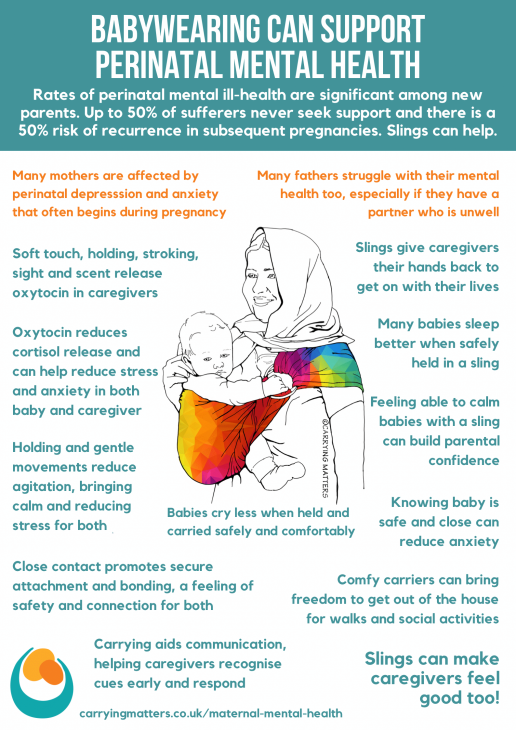
Educational Resources
This page contains various resources that may be useful for education and supporting others. Leaflets, posters and postcard packs can be purchased. Images and PDFs can be downloaded free of charge by clicking on the photos. Please ensure you credit me (Dr Rosie Knowles) if you use them.
Click on the image to download a PDF, or order a pack of high quality printed leaflets using the button below.
Click on the image to download a PDF, or order a pack of high quality printed leaflets using the button below.
Click on the image to download a PDF, or order a pack of glossy postcards or posters using the button below.
Click on the image to download a PDF, or order a pack of glossy postcards or posters using the button below.
Click on the image to download a PDF, or order a pack of glossy postcards or posters using the button below.
Click on the image below to download a PDF, or order A3 posters using the button below.
Click on the image to download a PDF, or order A3 posters using the button below.
Click on the image to download a PDF, or order A3 posters using the button below.
Click on the image to download a PDF, or order A3 posters using the button below.
Click on the image to download a PDF, or order a pack of posters using the button below.
Click on the image to download a PDF, or order a pack of posters using the button below.
Read Rosie’s well loved Why Babywearing Matters book here, published by Pinter and Martin.
Read Rosie’s well loved Why Babywearing Matters book here, translated into Polish by Lenny Lamb.
Snowsuits, Scarves, Slings and Safety - Carrying in the Cold
Autumn and winter can be a wonderful time of year, with frosty mornings and chilly walks, the first snowfall, and a little child nestled cosily up to you. Fresh air is good for the soul, and exercise and changes of scenery can make a big difference to family life. You don't need to be afraid of wintry weather, in fact, a baby carrier can help you go places!
It is important to consider safety in all things, and dressing warmly for winter while using a sling/carrier is no exception. Snowsuits may be cute and warm but they need to be used carefully.
When the weather turns chilly, or even icy, every caring parent’s mind turns to how to keep their baby warm in the cold air. Out come the snuggly snowsuits and the hooded jackets, out come the warm cosy scarves and thick cardigans, all aimed to keep you and baby toasty warm. At sling library sessions I can often be found encouraging parents to undress their babies, and often themselves! But why? Surely warmth is important?
Indeed it is, and it is good to be aware of your child’s needs. But there is often still a question about the best way to keep warm when you are using a sling… are the snuggly snowsuits really the best option? Are they safe to use, especially with the current advice about avoiding thick coats in car seats? (see the link at the bottom).
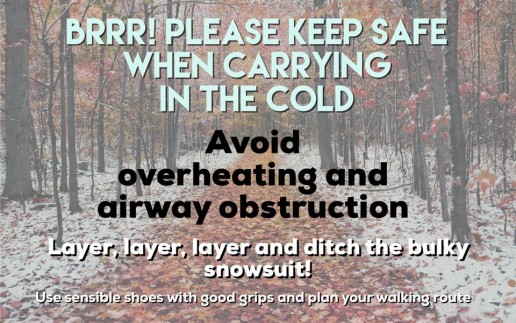
I see a lot of parents with small babies (under four months) in snowsuits or thick jackets who are then settled into a carrier, be it a stretchy or woven wrap or a meh dai or a buckle carrier. Problems can arise at this point; baby is often too warm, and may be rather sleepy as a result, or irritable, and the parent may be finding the carrier uncomfortable. Babies under 4 months are at greatest risk of difficulties due to their relative smallness weakness; they do not have strong and sustained head, back and torso control, so are more likely to run into problems. Older babies and toddlers are very different!
Let’s look at some of the major factors to consider when using a carrier in the cold.
1) Be aware of OVERHEATING
Too many thick snuggly layers can be a risk of overheating. Babies are by nature warm little creatures (carrying them can feel like having a delightful wriggly hot water bottle on your front) and it is their extremities and their heads that need protecting much more than their middles. They are not yet able to regulate their own temperatures in the way that adults can (which is why skin to skin contact from an adult for a feverish or cold child can be so very useful) so being close to your body will rapidly warm a child up anyway. As you walk you will warm up, and your extra heat will warm up the child on your front even more.
Being too hot is not good for babies; it makes them sleepy and overbundling a sleeping baby is a risk for SIDS (sudden infant death syndrome). It makes sense to avoid this overheating in slings just as much when baby is sleeping in a bed or a car seat. Furthermore, being too bundled up reduces their ability to sweat (the drops of sweat need to be able to evaporate to carry heat away) which means even older children who can regulate their temperature better will also struggle with being too hot. Hot babies are at significant risk; it is relatively easy to add extra layers for warmth if you misjudge slightly and to remove them when you come in out of the cold.
.
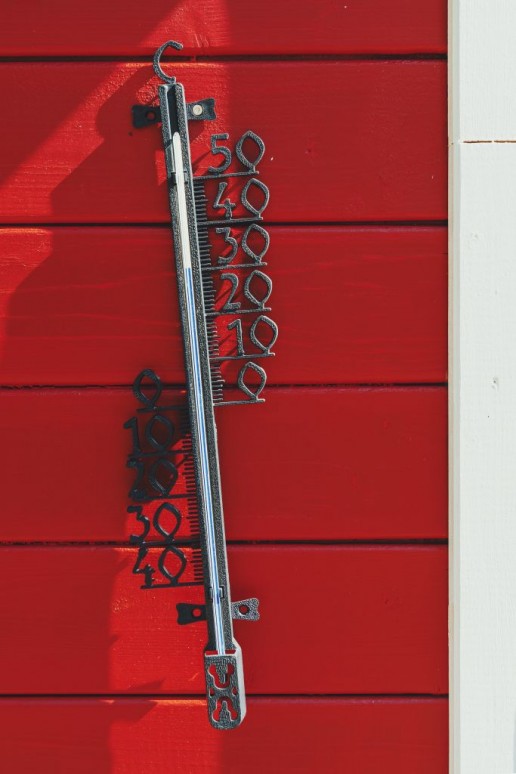
2) Be aware of AIRWAY
Sometimes the weight of baby inside the snowsuit can mean they sink down inside it, due to gravity, and end up with their faces buried inside the body of the snowsuit. This may pose a risk to airway and breathing; the same goes for hooded jackets or thick cardigans that can “ride up” the back of the carrier.
Too much fabric around the chest and upper body will also make it hard to achieve a fully supported back and a tight carry. This may increase the risk of too much space between baby’s head and your chest, allowing his chest to curl and compress and his heavy head to slump forwards, potentially compressing his airway, or burying his face into fluffy fabric, reducing airflow. Thick snowsuits really can be a significant risk.
Always ensure good airflow. Be aware of your own clothing too; a cowl or a scarf may prove problematic if your baby snuggles his face into the fabric, reducing free airflow. This is more of a risk with smaller babies than in those who have head control and are able to move themselves independently.
Make sure your baby’s face is not obscured by scarves or fabric that could be problematic if they fall asleep.
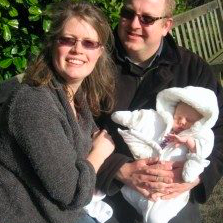
This little boy is too small for his snowsuit; if he was placed inside a sling his face would disappear into the fluffiness.
3) Be aware of POSITION
Increased bulk can affect positioning considerably. It is hard for joints to bend easily in thick, stiff trousers or multiple layers of clothing, so the M shape with bent knees higher than bottom that encourages healthy hips and protects the natural curve of the spine into a J shape can be hard to achieve. Baby may end up being “starfished” into a carrier with a hyperextended posture, rather than being comfortably seated.

Baby will feel heavier as he is not resting against the parent/carer’s body in the same way, and the weight distribution will change.
Too much bulk around the top may also affect the support to baby’s upper body, meaning that baby’s weight is pulling back away from your shoulders, rather than resting on your chest, and may be more uncomfortable.
Too much padding around the nappy region (especially in those babies wearing cloth nappies) could cause a reduction of blood flow to the lower limbs.

Baby above, has been straightened into a starfishing shape as the snowsuit is preventing his hips and knees from bending. however baby below is in the M shape.
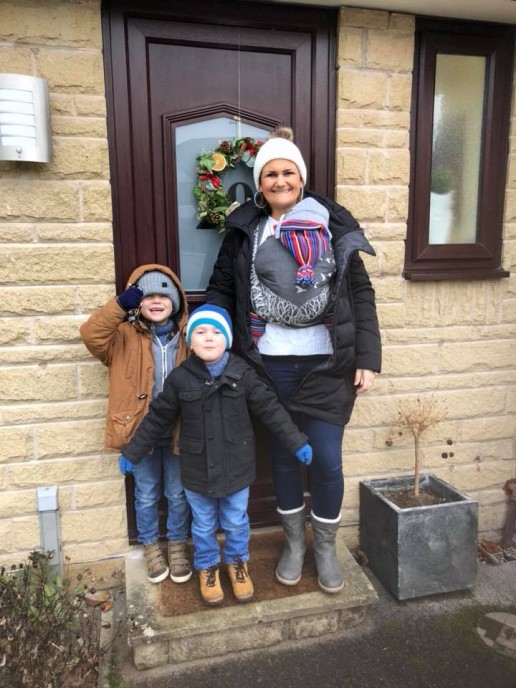
OK, so this is good to know. But it’s cold out there! My baby needs to be warm, what can I do?!
Here are some suggestions how to ensure your chilly weather carrying is safe and still snuggly warm.
If you need to go out in windy and cold conditions, or snow storms, your small baby will be warmest and best protected close to you on your front, here you can shield them from the wind and horizontal snow flurries easily.
Back carries for older children may be easier for you to see your feet as you go but be alert to their experience and ensure they are well protected. Carriers that keep children close to your body will be warmer and less likely to make you feel off balance as you walk, compared to framed backpack carriers worn high on the back; these will also be very cold for children as they are held away from body heat and more exposed to wind chill.
1) LAYER LAYER LAYER – carrying under coats
This is key to virtually all carrying, as the sling is in itself a layer of clothing, and sometimes more than one, depending on its type. A stretchy wrap is three layers, and some are thicker than others. Some buckle carriers are double layer panels, some are three. Every parent/child combination have their own micro-climate too, so what feels right for one family may be different for another.
In hot weather, you need as few as you can manage safely, whereas in cold weather you need more layers. Layers trap air in between them, so can often be more effective at providing warmth than one or two thick items of clothing, while still allowing flexibility.
Thin light all-in-one fleece suits are warm, while still being breathable and allowing good joint movement for positioning. It may be worth considering a size up to protect little toes with the riding up you get with a sling, however, too large a fleece could mean too much fabric around the face and neck. Layer up with vests and onesies and cardigans and leggings and so on, rather than using a very padded or furry inflexible snowsuit, you will be surprised how warm babies can get!
It is best, if possible, to keep baby as close to you as you can, and add layers on over the top. These layers can be undone/removed easily if baby is getting too hot (flushed, very warm chest skin, sweating, unexpectedly sleeping, for example), or if you go inside into a warm shop from a cold outside.
Wearing a large (maternity or oversized) coat which you can then wrap around your baby on the front will add warmth, as will a mac in rainy weather.
If you are creative, you could knit yourself a panel insert which would button onto your favourite button coat, making it wider to fit your baby and the sling inside. You can do the same with a zip insert (check before you buy that the zip insert fits onto your own zip). If you are innovative, you can use a large oversize hoodie or cardigan with a very big neck or a zip that can be undone to go over both of you, or wear an oversized coat backwards if you can get someone else to do up the zip. Others may use a large shawl to wrap around themselves, or a home-made fleece poncho.
There are many babywearing coats or ponchos or vests and other items of clothing on the market which have been specifically designed for this, such as the Mamalila, Lenny Lamb, Zoli, Wombat, Momawo, Liliputi coat ranges (among many others), Boba/Lenny Lamb/Angelwings hoodies/fleece vests, to name just a few, and many are suitable for back carrying.
Some can be expensive; for many they are invaluable especially if they are used frequently for back carrying (many maternity coats or extender panels do not allow back carrying) and some are stylish enough to be worn as normal coats to make them worth the outlay. Some will have hoods for both parent and baby, some won’t – it is worth doing your homework and trying a few before you splash out.
There are also some babywearing covers, similar to pushchair covers, that can just go over baby and sling but not parent, which may be useful if the parent prefers less warmth (such as Bundle Bean or Isara).
In rainy weather, some will use large anoraks over both baby and parent. There are several waterproof ponchos or covers on the market which can go over the sling on the top and umbrellas are very useful. Some creative folks have even threaded the arms of cross strap buckle carriers through a child’s waterproof anorak to cover over the panel!
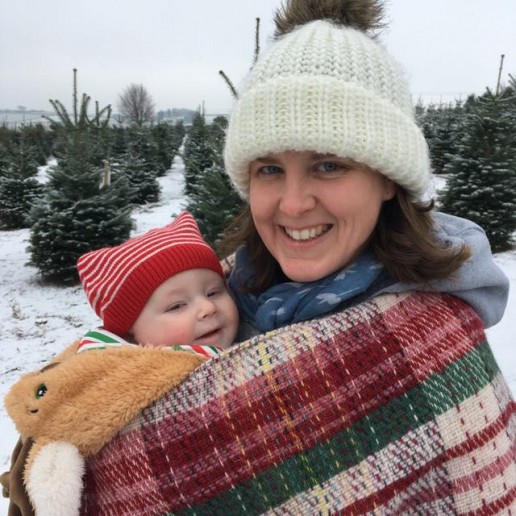

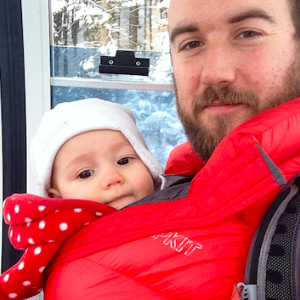
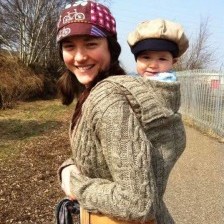
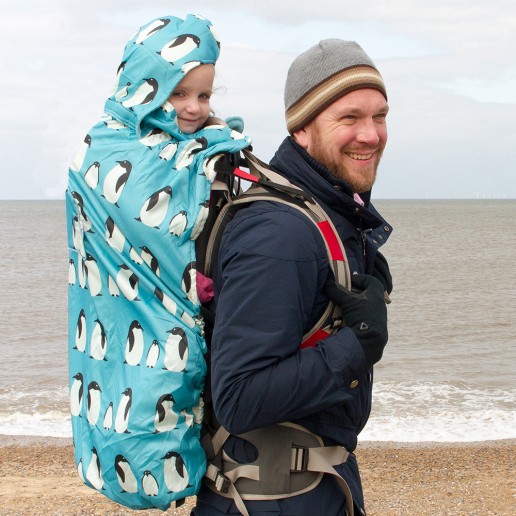
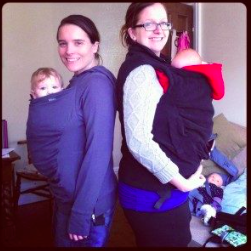
2) PROTECT EXTREMITIES
So if your baby’s body is nice and warm, heads and limbs need to be kept warm too.
This is where things like baby leggings, tights and socks can be very useful indeed, layering up over the feet. Some people find boots helpful as well, such as Stonz or Thinsulate boots (varying price ranges) or wooly booties that can be tied gently on to avoid falling off. Some fleece onesies have feet that can be folded over to make a closed foot. Feet can get much colder than hands as they are harder to tuck in near the warm central core.
Heads can be kept warm with hats…(of which there are many gorgeous options). Some opt for balaclavas with neck covers and various hoods to keep necks warm and prevent removal!
Hands can be kept warm with gloves with ribbons sewn in to stop them from falling off, or socks worn on the hands. Many fleece onesies have sleeves that can be folded over hands.
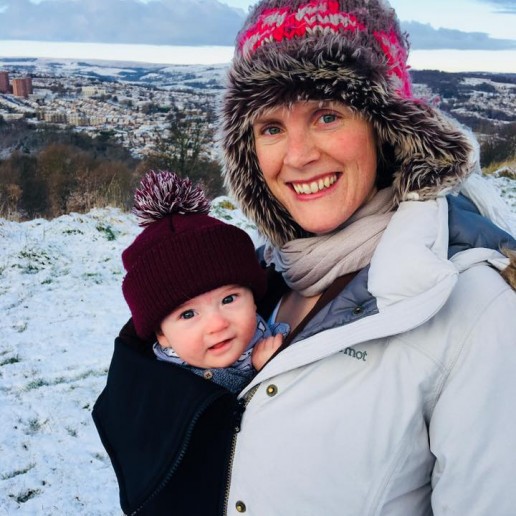
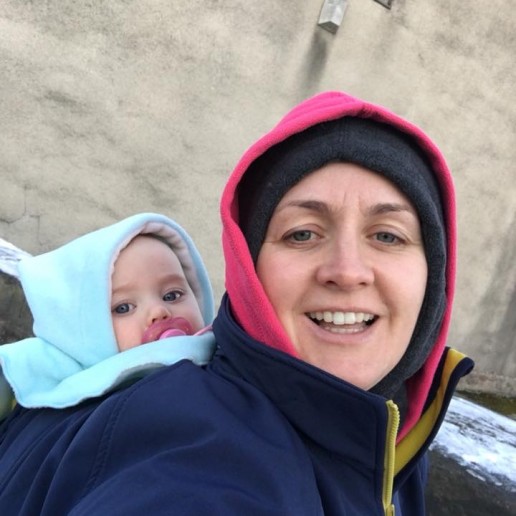
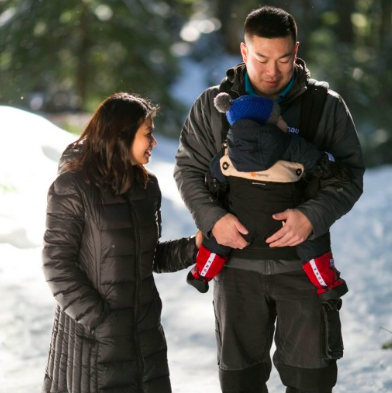
3) MANAGING CARRYING OVER COATS
This tends to work better for older babies or toddlers who want to be up and down all the time, and can work well in some circumstances, depending on the coat, the carrier and if you have anyone to help you. It can be hard to get a sling snug over the top of a bulky or slippery coat, and hard to get a snug fit on the back without help, but for many this works well.
Taking some care when planning the coat you use will make a big difference, (one that is thin and grippy, for example may be easier to work with, and hoods may get in the way of unobstructed breathing). Selecting the sling you use matters too; what you choose for normal use for maximum comfort may prove too complex over a coat. Pick one that is easily adjustable, and easy to get on and off.
This style of carrying over coats on the back may be much more convenient for toddlers who prefer to be able to get up and down again in quick succession. They are more likely to get cold on your back as they cannot snuggle into your body heat in the same way, so will need to be much more warmly dressed than a smaller baby on the front. This is especially true for framed carriers that hold children high up and separate. These children are not at the same risk of slumping over inside over-large suits and ending up with an obstructed airway, and as they are outside your coat, they will get cold. Snowsuits (that fit and are still flexible) can be an excellent solution here, as can waterproofs over coats and snuggly trousers.
Hands and feet will get a lot colder with this type of carrying, so make sure you are prepared.

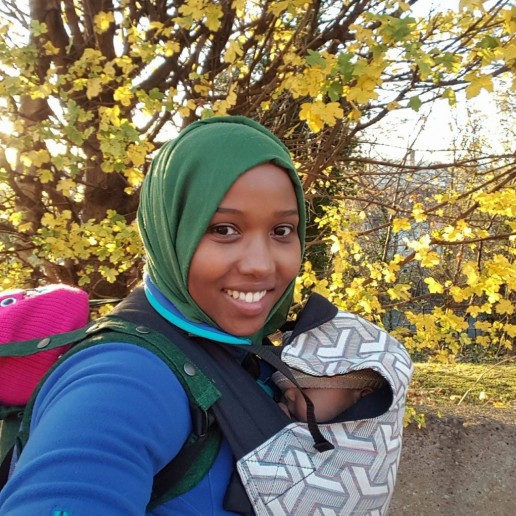
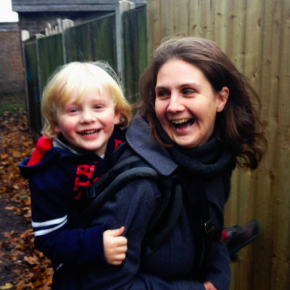
CARRYING IN SLIPPERY WEATHER
It is fantastic to be able to explore in freedom with your child in all weathers. But what about, even if you have the choice of sling and clothing right, the ground is icy and slippery?
CHOOSE SENSIBLE FOOTWEAR!
If carrying in the snow and ice, slip-on ice gripping covers (eg Yaktrax or other brands) that can go over shoes and boots can be enormously useful to prevent slipping… and if you do slip, your baby will be much safer in the sling than she would be loose in arms. Some metal grippers may not work well on mixed ground, as they may slide on smooth surfaces and can be hard to remove quickly, so have a good look at a few types and where you will need to use them before you pick one. It can be hard to remove them with a baby on your front, so plan ahead!
Good boots with grippy soles designed for all terrains may be worth investing in. Some families have used very large knitted socks over their shoes for grippiness over snow and ice when they know there are also stone stairs etc on the school run and they don’t want to go flying.
Some people recommend front carrying more in slippery weather, as if you do fall, you can use your hands to break your fall and protect your child more easily than if you fall backwards. Some people prefer not to carry at all and to use a buggy! Use whatever tool works best for your circumstances.

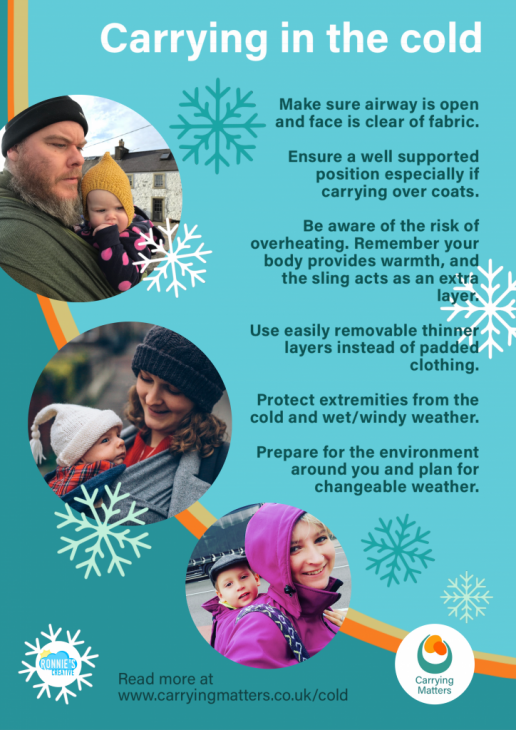
Here is some more information about cold weather carrying from other sources
http://southlondonslings.co.uk/2013/11/12/carrying-in-the-cold/ and
http://stroudslingmeet.wordpress.com/2014/09/20/slinging-in-the-rain-and-cold-and-wind-and-snow/
Here is the link discussing winter coats and car seats..
Blog post originally written 2014, updated Dec 2017


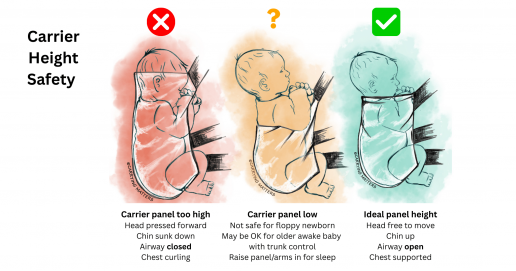
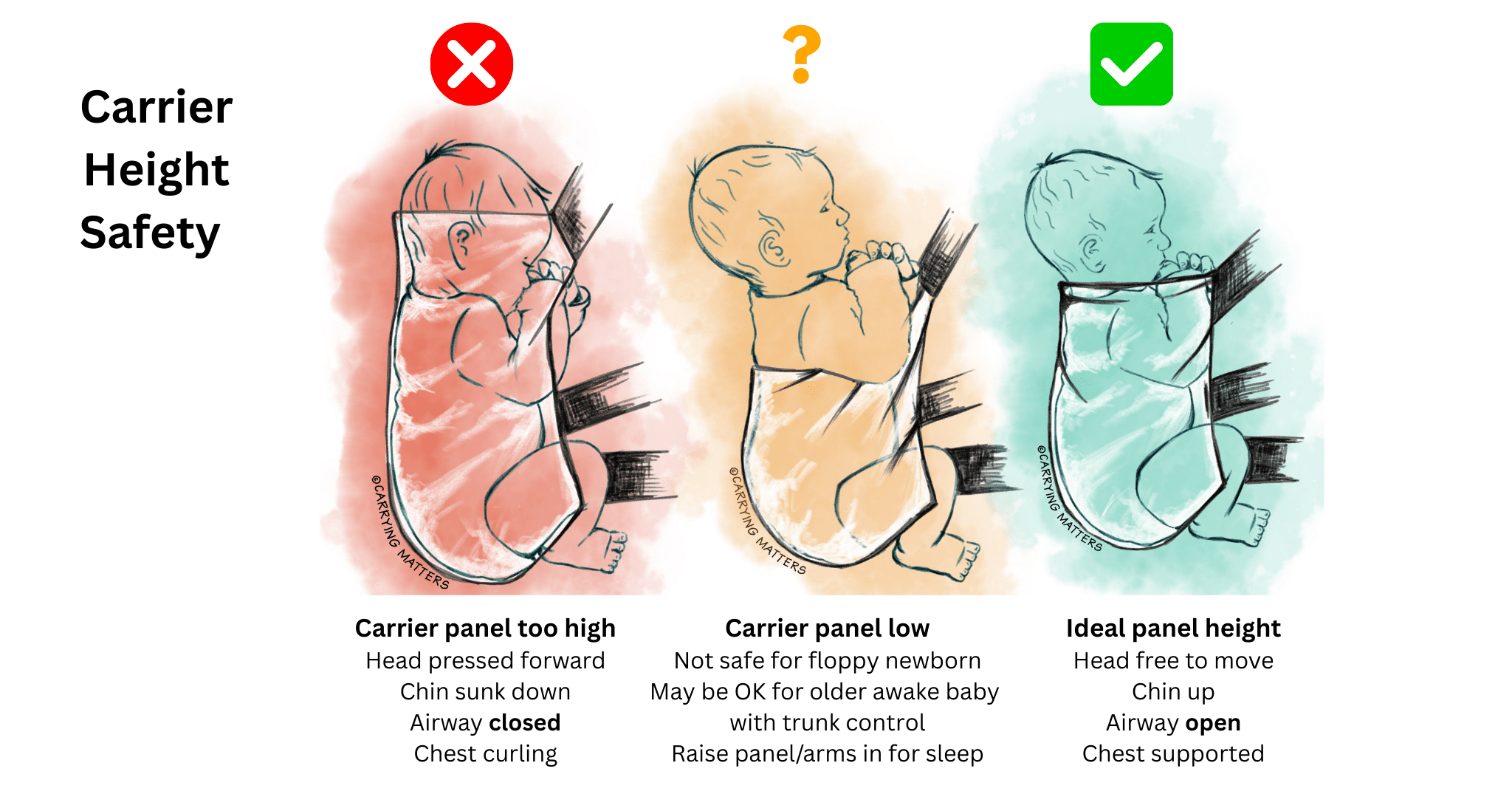
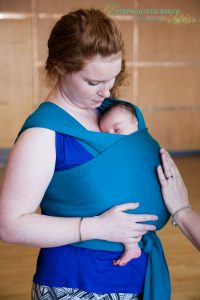
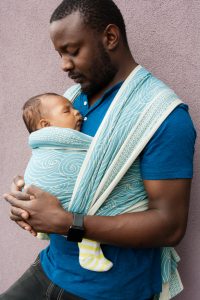
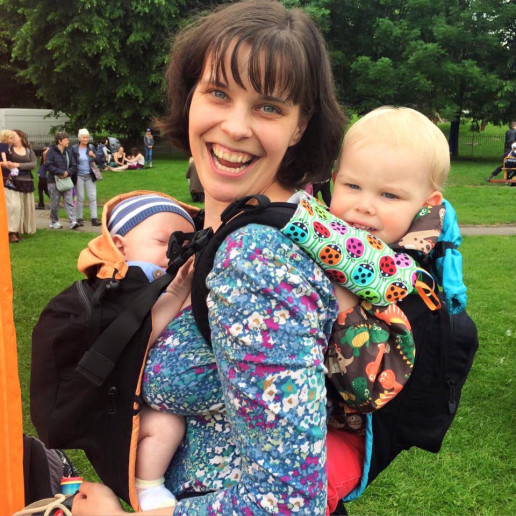


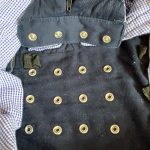

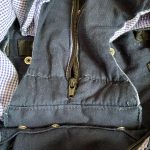
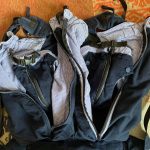
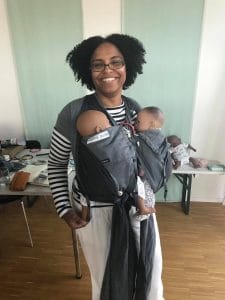
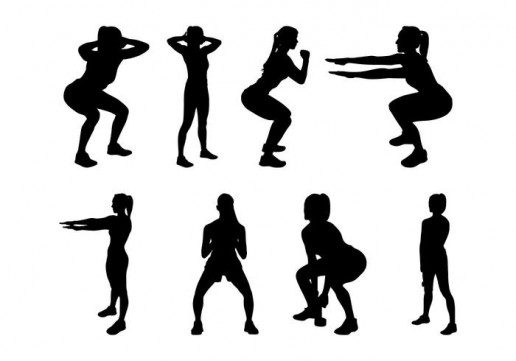
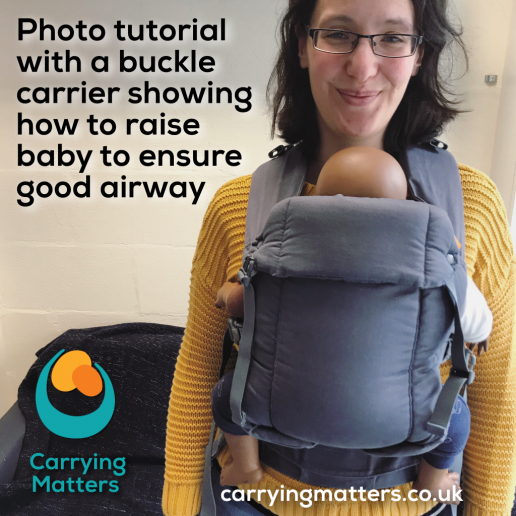

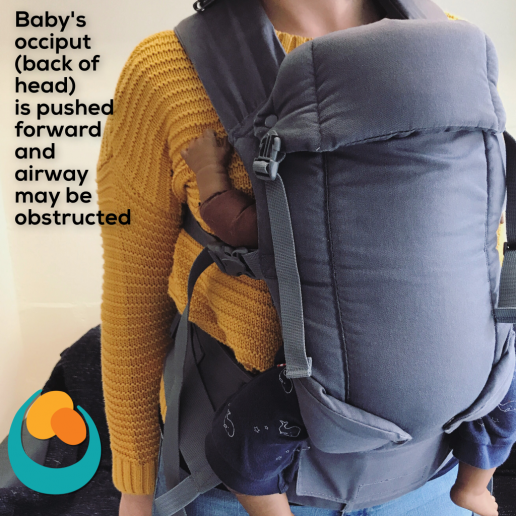
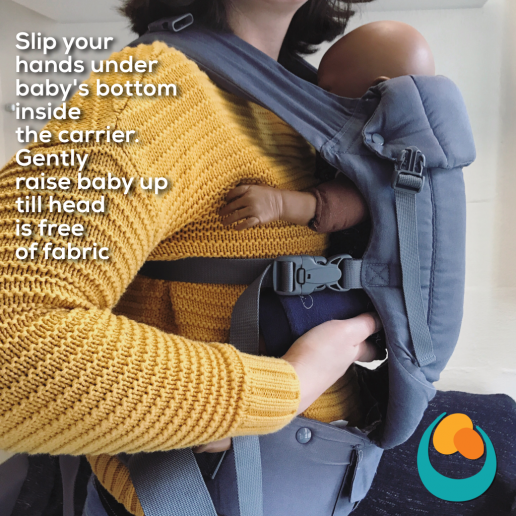
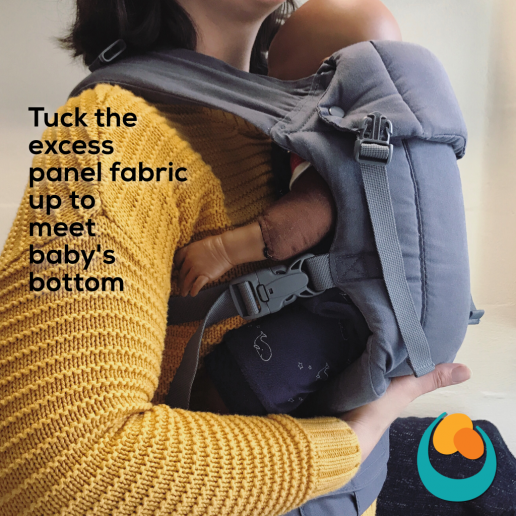
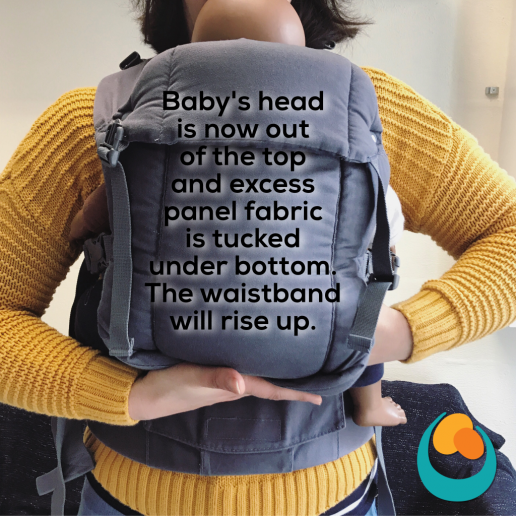
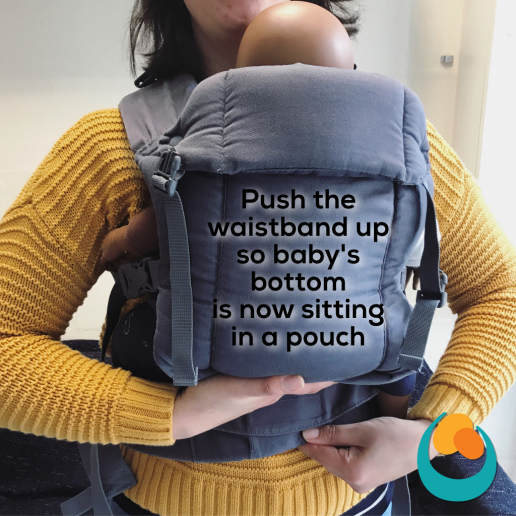
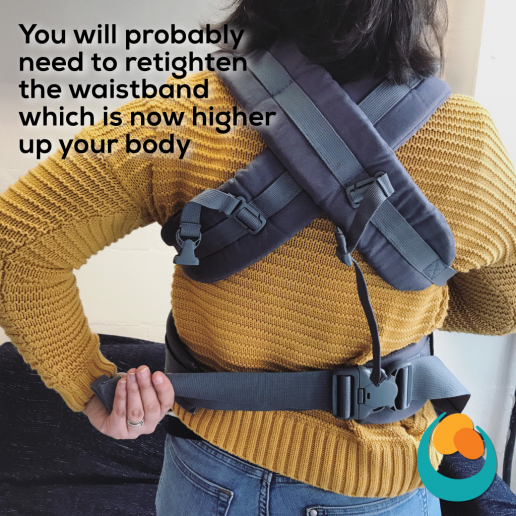
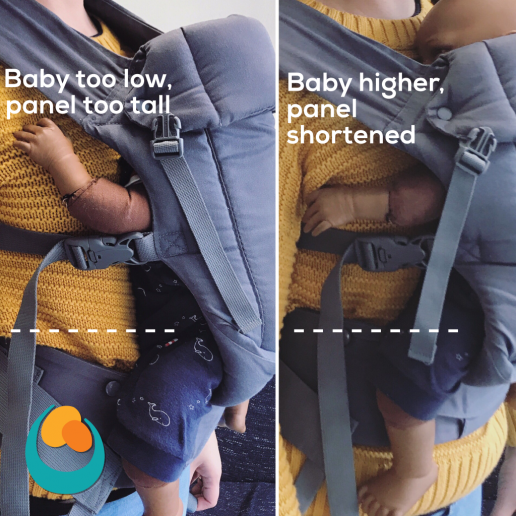
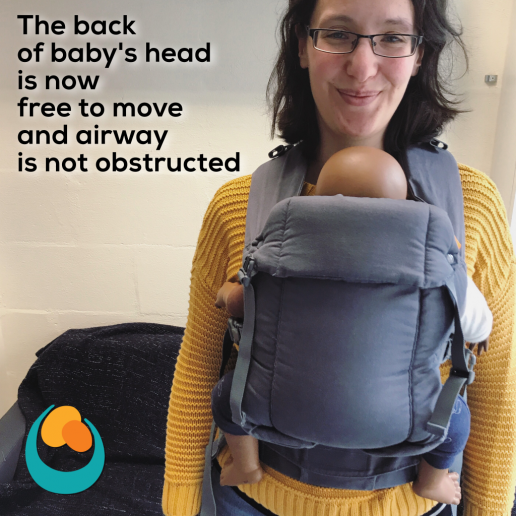
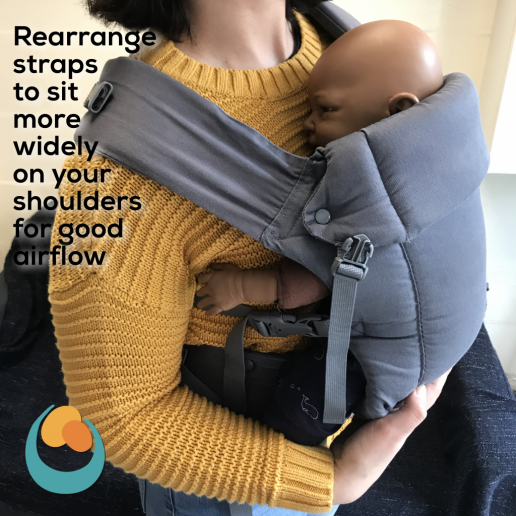
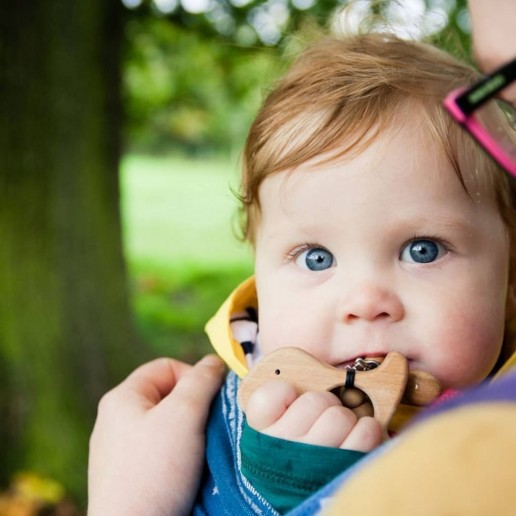

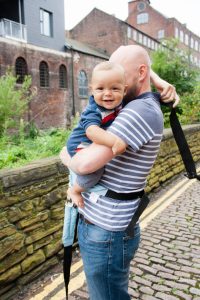 Get confident with a demo doll first. Sling libraries and sling consultants are usually well stocked with weighted demo dolls which will allow you to figure out how to use the sling safely (remember the
Get confident with a demo doll first. Sling libraries and sling consultants are usually well stocked with weighted demo dolls which will allow you to figure out how to use the sling safely (remember the 
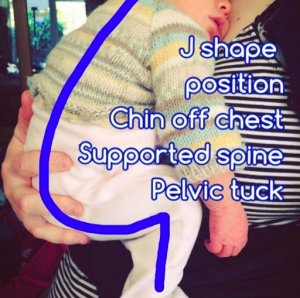
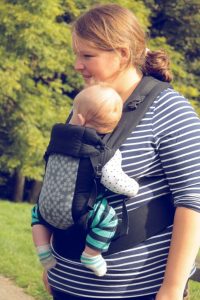 Remember that your baby still wants to experience the world even while carried, as they do when playing on your lap or on the floor. Help them to be able to see a little, in a way that is appropriate for their age and still respectful of growing spines and hips. A carrier that has straps or fabric that comes close to the face may be irritating (do remember that babies grow taller, and many carriers can be adjusted to ensure faces and heads not obscured). Make sure that there is some activity going on - we all know about the sway we do to settle babies when carried in arms, and how often we shift them around, or the rocking/pushing of the pram - this gives a child some sensory input, rather than remaining still. I often encourage parents to go for a short walk round the block when they have just put a sling on with their baby - the motion and movement to get out of the house and the fresh air and change of scenery usually works wonders and parents come back with happier babies. Of course, once the parent is standing still again, and baby is bored with the reduced activity, he will protest!
Remember that your baby still wants to experience the world even while carried, as they do when playing on your lap or on the floor. Help them to be able to see a little, in a way that is appropriate for their age and still respectful of growing spines and hips. A carrier that has straps or fabric that comes close to the face may be irritating (do remember that babies grow taller, and many carriers can be adjusted to ensure faces and heads not obscured). Make sure that there is some activity going on - we all know about the sway we do to settle babies when carried in arms, and how often we shift them around, or the rocking/pushing of the pram - this gives a child some sensory input, rather than remaining still. I often encourage parents to go for a short walk round the block when they have just put a sling on with their baby - the motion and movement to get out of the house and the fresh air and change of scenery usually works wonders and parents come back with happier babies. Of course, once the parent is standing still again, and baby is bored with the reduced activity, he will protest!